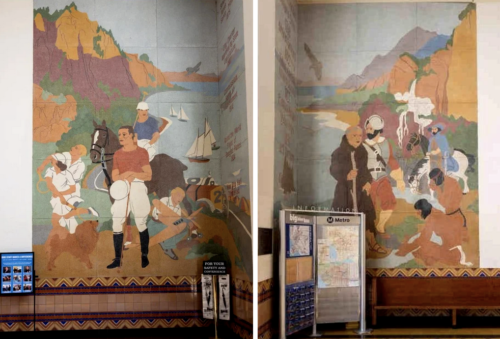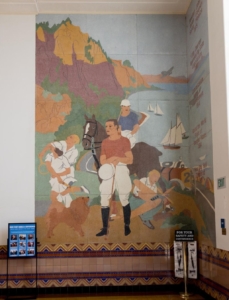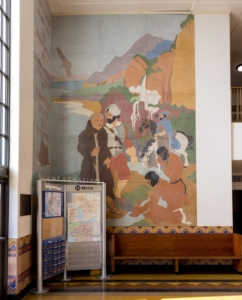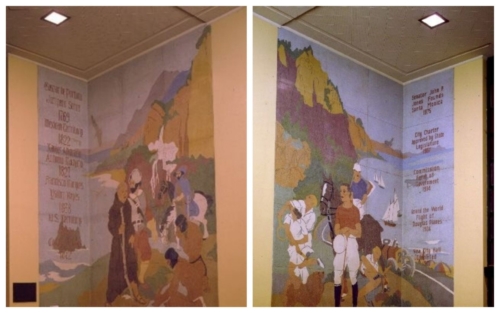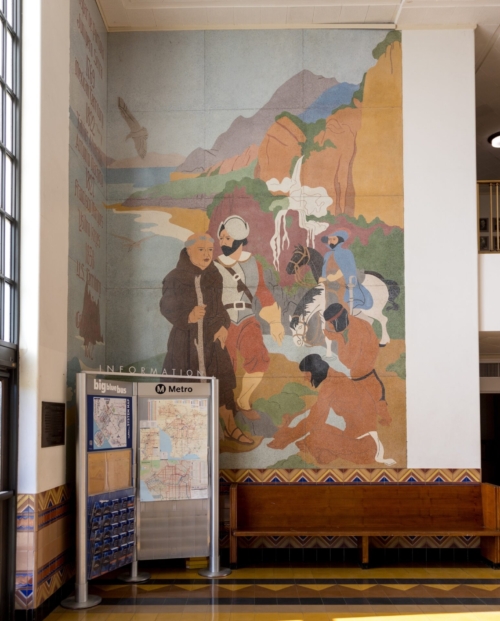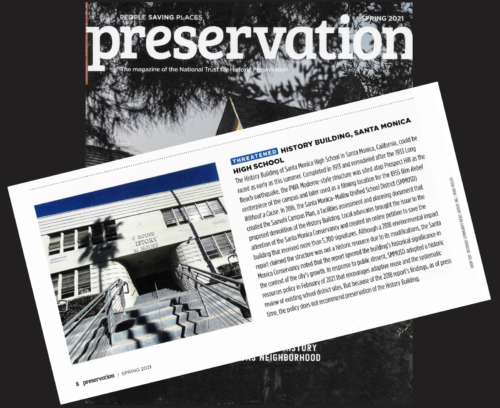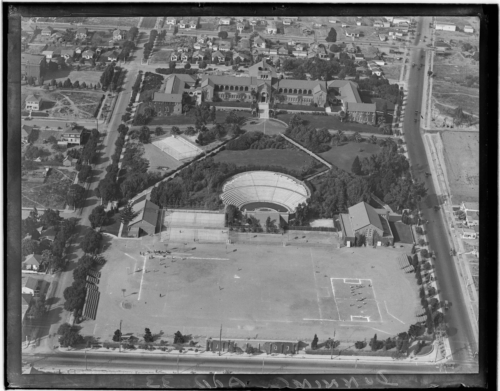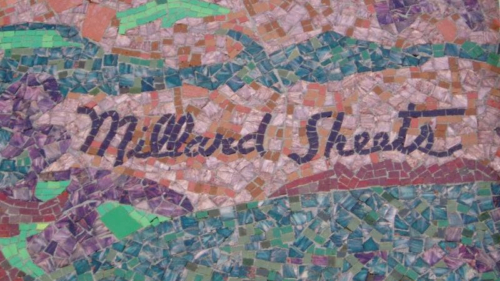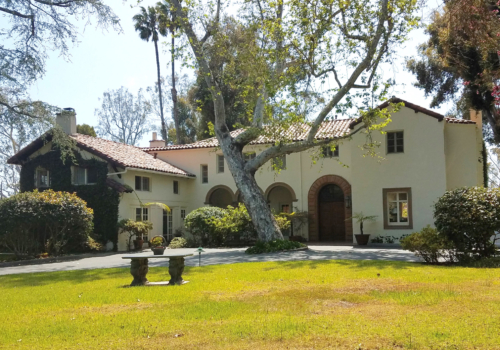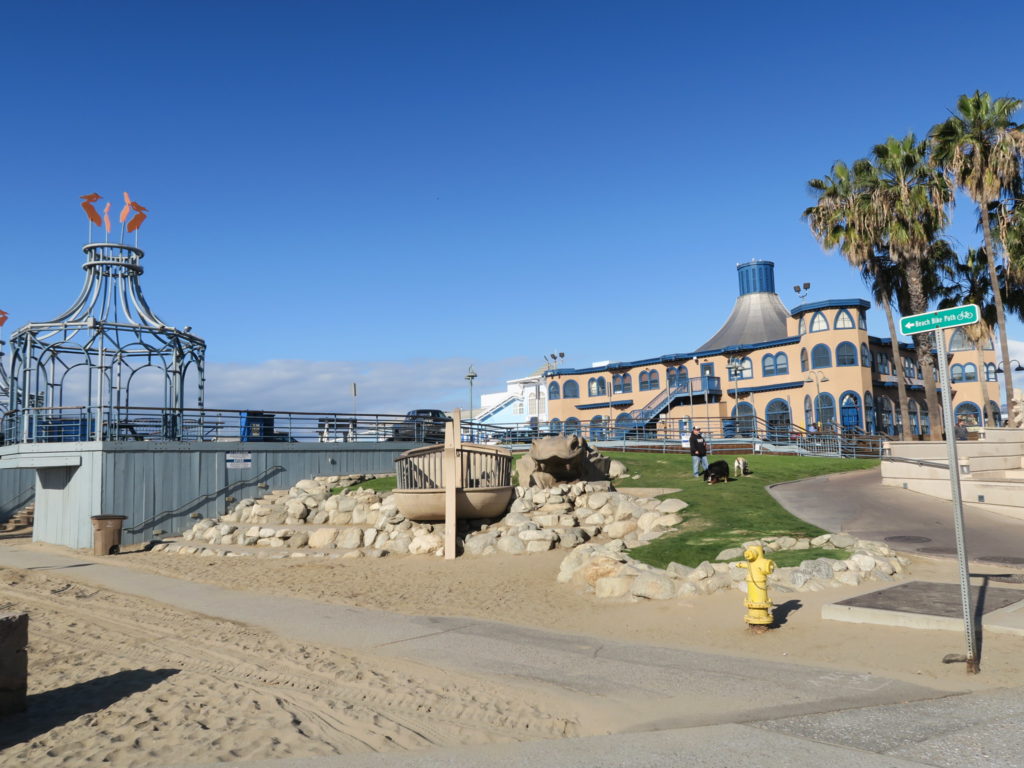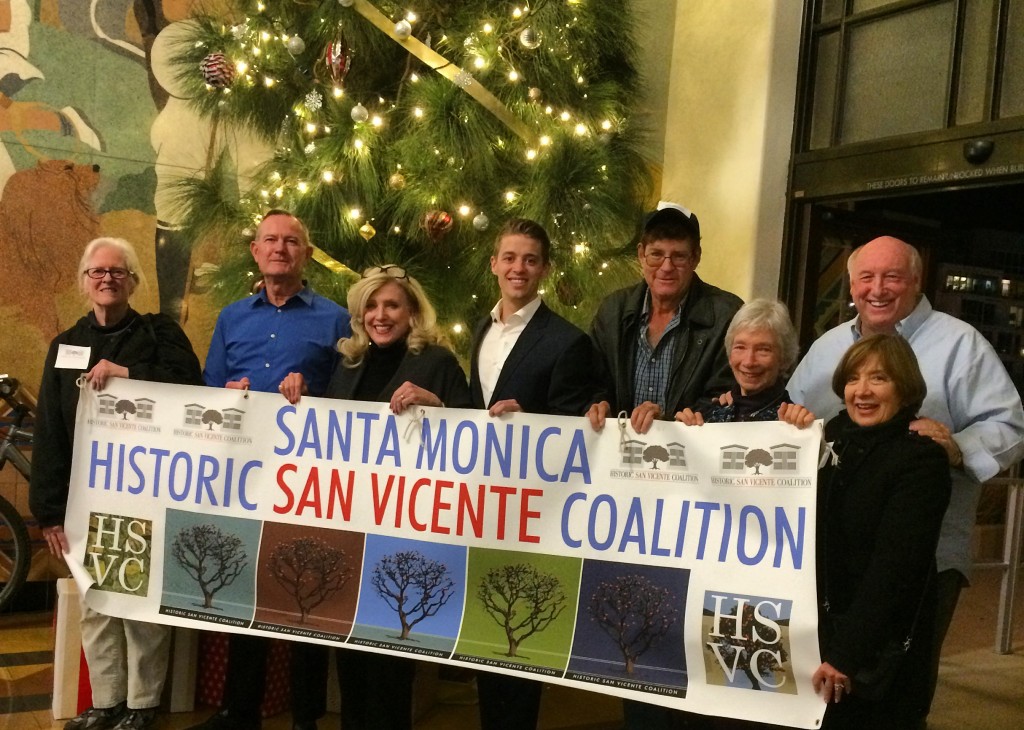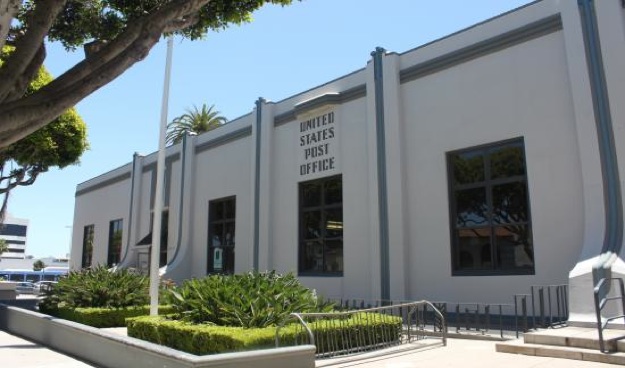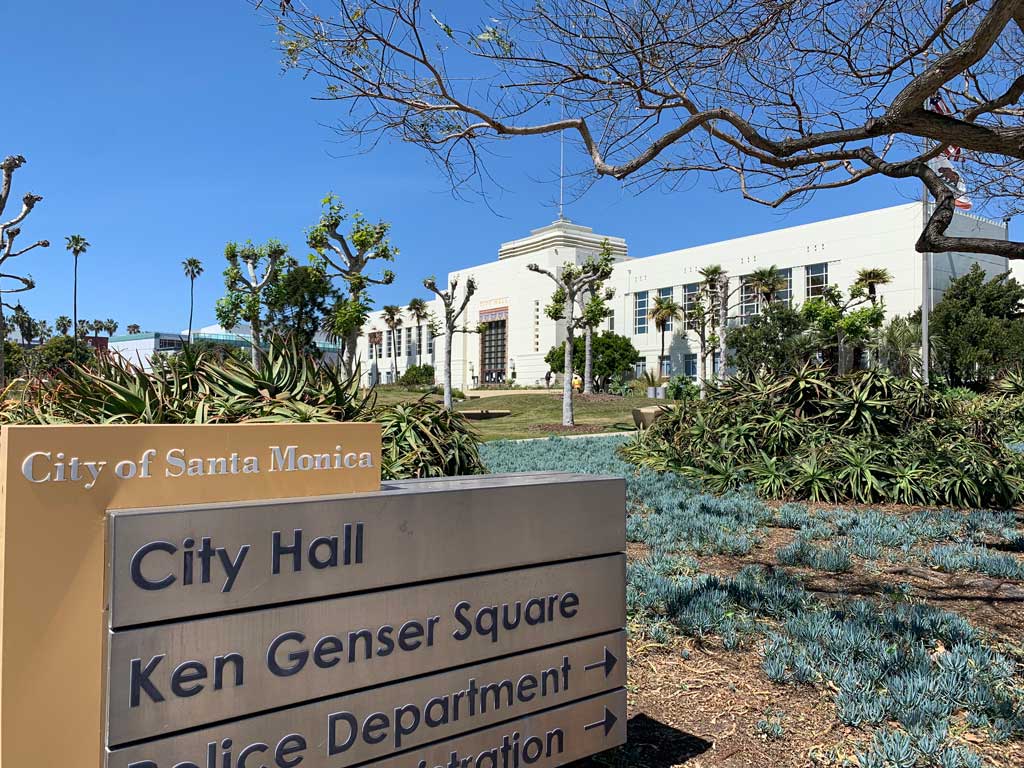
Preservation Alerts + Issues
Advocacy Alert! Santa Monica City Council to Discuss Potential Zoning Changes on Main Street, Montana Avenue and parts of Ocean Park and Pico Boulevards
Posted on February 22, 2023
Tonight at 6pm the Santa Monica City Council will hold a special meeting to discuss the new Housing Element including potential zoning changes on Main Street, Montana Avenue and parts of Ocean Park and Pico Boulevards.
Here at the Conservancy, we salute the diligent efforts being made to meet the need for housing, particularly affordable housing. We also have deep concerns about recommendations in the current zoning proposal that would allow for buildings at effectively double the height and across multiple lots in the neighborhood commercial districts of Main Street, Montana Avenue and parts of Ocean Park and Pico Boulevards.
Specifically, the proposal to allow 55 ft. high heights and lot consolidation in these areas threatens to undermine the character of our City’s most pedestrian-oriented commercial areas which are home to many of the City’s historic resources and small local businesses. Allowing new construction at this scale would also create large floor-plate retail spaces only affordable to corporate tenants, likely wiping out many existing local small businesses all together.
We think there are other parts of the City with underutilized potential for new housing opportunities, including our major commercial corridors. It is our position that these smaller neighborhoods are not the right place to build necessary housing.
Click here to read the Conservancy’s official letter, sent as public comment for tonight’s meeting. Click here for the meeting agenda. Public comment is now closed, but the public can attend the meeting in person at City Hall Chambers, 1685 Main Street, Room 250, or watch live here. A recording of the meeting will be posted here.
Please stay informed about this important issue and feel free to reach out to us at info@smconservancy.org with your questions!
Santa Monica City Council Candidates Weigh In on Historic Preservation
Posted on October 12, 2022
City Council members make crucial decisions – on landmark nominations that are appealed, on zoning constraints and incentives, and on other matters affecting the survival of our cultural resources. To help our members and friends evaluate the candidates’ understanding and knowledge of their important role in protecting and revitalizing our cultural heritage, we sent them each the same questionnaire:
1. What direct experience, if any, have you had with historic preservation locally or elsewhere? Please describe.
2. What do you see as the biggest barrier to Santa Monica’s stated goal of preserving its historic, architectural, and cultural resources? What obstacles or disincentives to historic preservation are you aware of?
3. In response to City budget deficits, City Council set up a full cost recovery system for all City applications, including for landmark designations. The current fees, around $6,000 to nominate a property for designation, are among the highest in the state. What are your views about this system?
Click here to read answers from: Whitney Baine, Albin Gielicz, Troy Harris, Armen Melkonians, Samantha Mota, Ellis Raskin, Caroline Torosis, Natalya Zernitskaya, and Jesse Zwick.
City Hall Murals: Acknowledge + Reframe Together
Posted on March 10, 2022
Your support empowered the successful advocacy to stop the City Hall murals from being covered. Santa Monica Cultural Affairs staff is moving ahead with community outreach and engagement through the launch of a new initiative, Acknowledge + Reframe Together (Reframe), which will support art and civic memory projects that center community voices with the aim of creating a more just and equitable Santa Monica. The Santa Monica Conservancy encourages your participation.
In particular, Reframe will focus on centering the voices and experiences of communities of color who have been historically excluded from discourse about representation in Civic spaces. Belmar History + Art (2019-2021) was a demonstration project that inspired this initiative, and Santa Monica Cultural Affairs is now embarking on a public engagement process around the WPA-era murals by Stanton McDonald-Wright in the historic City Hall lobby.
This will include gathering a diverse array of voices and perspectives through a series of community conversations and art activations, with the goal of commissioning new artworks that will convey more of this land’s history and better express our community’s values today.
The survey seeks to learn more about people’s ties to Santa Monica and their reflections on place and belonging. Please respond at the link below to help shape discussions and activities regarding the City Hall murals going forward!
City Council Unanimously Approves Request to Cease Installation of Temporary Scrim Over Murals
Posted on February 25, 2022
by Ruthann Lehrer, Advocacy Committee Co-Chair
On February 22nd, City Council unanimously approved a motion agreeing to the Santa Monica Conservancy’s request to not proceed with covering the historic murals in City Hall.
“Request of Councilmembers de la Torre and Parra that Council directs staff to no longer install a temporary scrim over the Stanton Macdonald-Wright murals in the lobby of Santa Monica City Hall and to instead direct staff to launch of a process that engages and educates our community and results in the addition of artwork within the lobby to create a more inclusive and complete story of our City’s history and vision for our future to advance the City’s commitment to equity, justice and respect for all and, in the interim, direct staff to explore the creation of a temporary lobby display around the themes that will be explored during the larger community education and engagement process.” (See the City Council agenda here.)
This motion reversed a prior action taken by City Council in May 2021 to cover the murals with a scrim because they were perceived as racist and not reflective of our current values. The Conservancy’s leadership helped to forge this positive outcome by advocating to preserve the murals in City Hall, which are landmarked, and providing education from a historic perspective while endorsing the creation of new information and public art to promote racial justice. To all our members and friends, who wrote letters and emails to City Council to support our position, we thank you – we could not have done it without your support.
Councilmembers de la Torre and Parra thanked the Conservancy for its constructive role and described some of the future ideas to implement their motion: creating new materials to engage children in understanding the themes of the murals and hiring a consultant to steer the community education and involvement process. We will keep you informed of those next steps.
Notable in this controversy was the failure of City staff to use the legal protections of our landmarks ordinance to acknowledge this potentially adverse action, and to refer this matter to the Landmarks Commission. The WPA-era murals by renowned artist Stanton Macdonald-Wright, a Santa Monica resident, were identified as character-defining features of City Hall when the building was designated in 1979 and reaffirmed in numerous City documents subsequently. The Conservancy will need to follow up to ensure that all material and spatial characteristics of City Hall interiors are recognized as having historic significance so that there is no misunderstanding in the future.
City Hall Mural Update
Posted on September 30, 2021
by Ruthann Lehrer, Advocacy Committee Co-Chair
On September 28th, City Council moved forward on assigning the Landmarks Commission the responsibility of interpreting and contextualizing the City Hall murals, supported by an ad hoc Council committee consisting of Oscar De La Torre and Christine Parra. Their role is to advise the Landmarks Commission and to make recommendations, participating in the Commission discussions. De La Torre is interested in issues of racial injustice while Parra is interested in interpretation and education. The Arts Commission will also be involved. Thanks to Councilmembers Himmelrich and De La Torre for initiating this positive step forward after meeting with a Santa Monica Conservancy representative.
While the content of the History mural panel in City Hall has been highly controversial (read our prior messages by clicking here), the companion mural that depicts recreation in Santa Monica has also been criticized. The images there appear to be elitist, upper class white people engaged in tennis, polo, aviation, auto races and sailing. (Click here for a 360-degree view of the murals.)
In order to understand why the artist, Stanton MacDonald-Wright, selected these images, it’s necessary to do research to try to find any statement that he made about that artwork. We found a transcribed oral interview with the artist at the Archives of American Art at the Smithsonian. Here is an excerpt in which MacDonald-Wright talks about the Recreation mural. Unfortunately, the interview does not discuss the History mural.
Betty Hoag: There are some details about the Santa Monica City Hall mural I want to ask you about . . . particularly the one where the polo-players are. Do you remember the man in polo jodhpurs standing in front, and then a man on a horse behind him with a mallet?
Stanton MacDonald-Wright: Yes, I remember.
BH: Did those have anything to do with Will Rogers and his polo field?
SM: Yes. And that airplane and the automobile are very distinctly related to Santa Monica. The biggest automobile road-races that they had in California at that time were held in Santa Monica . . . .
BH: On San Vicente Boulevard?
SM: I don’t remember whether they were there or whether they were on Wilshire Boulevard, I forget. Also the first airplane field, Rogers Field, was built and given to Santa Monica by the son-in-law of this fellow about whom I told you, Gorham; he is depicted there. Now the plane business was important then. The Douglas building is shown in the mural. Douglas was the first great airplane-builder in the United States. And the tennis players! Remember, the best tennis players, the world champions, were all developed in Santa Monica: May Sutton and the Ryan girls and May Sutton’s daughter and Tom Bundy (who was later her husband) played in the doubles, and so on. All the greatest tennis players. So all those were put in the mural for good reasons.
What we discover is that the artist selected recreational and spectator sports that were huge visitor attractions and which drew people to Santa Monica. The images were chosen in the spirit of boosterism, pride in recreational activities that made the City famous. MacDonald-Wright was a Santa Monica resident who was quite knowledgeable about the City’s history and attractions.
Letters from the Marquez and Reyes Families in Response to the City Hall Murals
Posted on September 6, 2021
by Ruthann Lehrer, Advocacy Committee Co-Chair
The Santa Monica Conservancy has been reporting on a new City Council initiative, adopted on May 11, 2021, to cover the historic murals inside the City Hall lobby with a fabric scrim, and “recontextualize” the cultural history of the Tongva people with reference to our current perspectives on social justice issues.
The Conservancy strongly objects to covering the murals, which are important features of our landmarked City Hall, but we support creating new narratives about the artwork. The new narratives should explain the main subject matter of the History mural, which was the first encounter of the 1769 Portola expedition with the Tongva people at the Kuruvungna Sacred Springs, now restored at University High School. The History mural’s images and text refer to evolving layers of our history, including the Rancho period. While the discussion has focused on the Tongva people’s story, there is a broader history at risk here.
We look forward to a process of robust public engagement, with public participation, about expanding the historical narrative and contemporary perspectives on social justice, in the form of new exhibits in City Hall and in the City’s public art program. Exactly what those should be remains to be determined.
The immediate need is to convey our objections to covering the murals. In response to the Conservancy’s previous messages on this issue, other voices have come forward to express their opposition to City Council’s censorship of the historic murals. We would like to share letters written by Terri de la Pena and Sharon Reyes, whose family histories are woven into the fabric of Santa Monica:
Honorable Mayor Himmelrich and Councilmembers:
One of the historic names that appears on the City Hall mural is that of our great great grandfather Francisco Marquez. As native Santa Monicans, we have always been proud of the fact that our ancestor is honored there.
When Mexico gained independence from Spain in the 1820s, the new government secularized the sprawling California mission properties. This allowed Mexican citizens in good standing to be awarded these lands. Rancho Boca de Santa Monica was first granted to Francisco Alvarado and Antonio Machado (also on the mural) in 1827. When they relinquished their rights in 1838, Francisco Marquez and his partner Ysidro Reyes obtained the land grant in June 1839. Since then, several generations of the extended Marquez and Reyes families have lived in Santa Monica and/or neighboring communities.
If the historic City Hall mural is covered up or destroyed, what becomes of our history? The Marquez and Reyes descendants have been in this area for over 180 years. If Santa Monica truly wants to be seen as a diverse community, what about those of us who are land grant descendants, who have lived here all our lives? Our history is part of the Santa Monica story too. Don’t we also have a right to be recognized?
Please do not pick and choose whose history ought to be depicted. Our families have long been here and we deserve to be acknowledged for that. Please do not cover up or delete our ancestors’ names from the mural.
Sincerely,
Terri de la Pena
Marguerite de la Pena
Rose Marie de la Pena
Daniel and Mary Cady
Dianne Marquez
Honorable Mayor Himmelrich and Councilmembers,
My father, Ysidro Reyes, was named after the co-owner of Rancho Boca de Santa Monica.
He was always telling our family this one quote: “So many people say, ‘Who wants to hear about the past?’, but we must know where we’ve been before we can see where we’re going”
When I was about six years old, he took me and my sister to City Hall to see the mural. He pointed out the colorful historical background, including the story of the springs on the University High School campus and how our city was named.
Returning to City Hall as an adult, I was even more struck by the fact that I am related to the men mentioned on the mural. Antonio Machado, Francisco Marquez and Ysidro Reyes. I grew up hearing stories about my great aunt Arcadia Bandini, as well as J.J. Carrillo and Sheriff Eugene Biscailuz, people who were instrumental in Santa Monica’s history.
Even after my family suffered the loss of their land and the total disregard of our heritage, for over 180 years we have remained woven into the fabric of California history. I was raised to be proud of this history, so why would anyone want to cover it up after it’s installment 84 years ago?
We need to preserve the artist‘s work as well as the history he portrayed. Future generations need to know about the city and how this region came to be.
My cousins and family below are proud of their history and want this mural and story displayed for another 100 plus years. We are stern in our objection to the distasteful covering of the mural.
From several of our Boca de Santa Monica family descendants:
Sincerely,
Sharon Reyes
Leo Marquez
Joe & Paul Villasenor
Ricardo Bandini
Ruben Lucero
Rose Enriquez
Ed Tynan
Ronnie Mendez
Lisa Marquez
Sharon Kilbride
Vincent Olivera
Kevin Reyes Siebuhr
Sean Reyes Siebuhr
Natalie Reyes Scott
Kathleen Reyes Kelly
Michael Serra
Debbie Saenz
City Council to Cover Up City Hall Mural
Posted on July 23, 2021
by Ruthann Lehrer, Advocacy Committee Co-Chair
A stunning development: On July 12th, the Landmarks Commission was informed that the City would go ahead and install fabric screens over the historic murals inside City Hall, bypassing the legally required review by the Landmarks Commission set forth in the Municipal Code. City staff is justifying this deviation from the legal process by creating “alternative facts” and describing the fabric as merely interior decoration, a minor adjustment of furnishings in City Hall like putting in a new desk or sign. This is a cover-up of the cover-up!
As we have been reporting (see our advocacy efforts here and here), the fabric screens are intended to censor the historic murals created by famed artist Stanton MacDonald-Wright as part of the Works Progress Administration program that this artist directed in Southern California. City Hall is designated as a WPA Landmark and the murals are protected as significant features. The Municipal Code requires the Landmarks Commission to review and approve all proposed changes to designated landmarks through a Certificate of Appropriateness process.
The decision to evade the responsibilities of Landmark designation is unprecedented. It’s all the more egregious for taking place at the heart of our City government.
Though reactions to the murals today vary, there is widespread agreement that there should be accompanying narratives that explain their historic context as well as explore multiple themes of social injustice that characterize California history. Covering the murals, which prevents thoughtful preparation for a public process of engagement in this history, is an act of politicized censorship. It is not what we expect from a City that considers itself progressive and enlightened.
Interpretation of art that reflects our difficult history should not be politicized; the art should be analyzed and discussed so that different points of view can be expressed. The murals should remain on view so those who wish to participate can think for themselves. We urge City staff to begin immediately to develop an appropriate process that will result in a meaningful interpretive program for the murals.
Update on City Council’s May 11th Decision to Cover Up the City Hall Murals
Posted on June 22, 2021
by Ruthann Lehrer, Advocacy Committee Co-Chair
The interior public lobby of City Hall as well as its architecture are protected historic resources designated in 1979, and the Stanton MacDonald-Wright murals are specifically identified as important features. The Municipal Code defines the process to be followed if alterations are proposed. The Santa Monica Landmarks Ordinance clearly indicates that the Landmarks Commission must review this alteration under the Certificate of Appropriateness provisions.
Such protections are fundamental to the entire program for the survival of designated historic resources, and those located at the heart of our civic government are the most obvious examples. The Santa Monica Conservancy, with the advice of our attorney, has communicated this message to the City Manager, City Attorney and City staff in a letter, and we are awaiting a response. (See our previous advocacy efforts here.)
If this process is followed, the Landmarks Commission would conduct a public hearing on this application, as it has for other applications affecting City Hall, such as the new Annex, remodeled entryway and Ken Genser Square. In addition to public testimony, the expertise of the Landmarks Commission could provide guidance about understanding and interpreting the murals’ imagery and themes.
Because the image of the springs is so critical to understanding the History mural, we reached out to the Gabrielino Tongva Springs Foundation, the Native American group that restored the sacred waters at University High School and preserves them as essential to its history.
The History mural in City Hall depicts the first contact between Europeans and Native Tongva at the springs, and the naming of Santa Monica. Gabrielino Tongva Springs Foundation members seem keenly interested in preserving their history as depicted at Santa Monica City Hall. The Foundation also recently re-opened the sacred Kuruvungna Springs to the public on the first Saturday of the month; access is from Barrington Avenue south of Texas Avenue.
Members of the founding families of Santa Monica have also reached out to us, concerned about the eradication of their histories. Descendants of the Marquez and Reyes families from Rancho Boca de Santa Monica as well as the Bandini family find their stories referenced in the mural that will be removed from public view. Indeed, the name Ysidro Reyes is actually inscribed in the mural.
Companion to the History mural is one showing Recreation, depicting popular spectator sports — polo, tennis, auto races, aviation and sailing — that attracted visitors to the City. While these images seem elitist today, these recreational activities helped boost the City as a tourist destination.
Discussions about the murals’ future have affirmed that there is strong interest in a robust public discussion and debate about their historic context, their explicit and implicit meanings, and how we can educate our community about social justice. An interpretive explanation or exhibit is crucial for the murals as the touchstone for understanding the past and discussing issues of social equity and inclusion. But covering the murals does not advance that goal. At this intersection of history, public art and social justice, the Santa Monica Conservancy believes we have an opportunity to create public engagement and educate our community about our past and the value of preservation, and promote social equity.
Hiding History at City Hall
Posted on May 23, 2021
by Ruthann Lehrer, Advocacy Committee Co-Chair
City Council voted 6-1 on May 11th to cover the historic mural in City Hall as part of its efforts to eradicate racial injustice in Santa Monica. The mural depicts Native Americans at a natural spring and the arrival of a Spanish monk and soldier in the 18th century. It was created by renowned artist Stanton MacDonald-Wright who was Director of the Southern California Works Progress Administration, a program initiated by President Franklin D. Roosevelt that provided federal grants for artists to create public art in public buildings for Depression-era economic recovery. Part of the WPA project that is City Hall, the mural is part of a Santa Monica landmark.
As a history mural, there are indeed layered meanings, and implications about its subject. The mural shows two Native Americans kneeling by a natural spring, one drinking and the other with his hands in the water. The natural spring was the City’s first source of water, and still exists today in a nature preserve restored and tended by Tongva/Gabrieleno tribal members at University High School. Standing opposite the Native Americans are a Franciscan monk and a Spanish conquistador. Based upon Father Crespi’s diary of the Portola expedition of 1769, the scene represents the naming of Santa Monica.
The future subjugation of Native Americans may be implied by the positioning of the figures, and the mural evokes various phases of Santa Monica history, such as invasions of Spanish/Mexican conquerors and the Rancho period, when Native American lands were turned into large agricultural ranchos. California history has been rife with racial inequalities and social injustice, and the mural is a record of this difficult history.
The Arts Commission was poised to organize public forums to discuss the mural’s interpretation and how best to present it in its historical context while addressing racial injustice when the pandemic struck. The Commission is ready to do this again; however, with the shades pulled down and the mural obscured, it will be hard to have meaningful public engagement.
Rather than eliminate or cover the mural, what is needed are interpretative explanations alongside the City Hall artwork that place it in its historic context while engaging with issues of racial and social justice. The mural is an opportunity to educate our community about the original Native residents of the region, the founding of Santa Monica, the unfolding of California history in which Native Americans were decimated and how this history continues to impact our city and state. And so it’s not only important to preserve the mural, but to use it as an educational tool in a civic space. Additionally, the City should be proactive in using our public arts program to create new works that gives voice to our under-represented communities, like the Belmar History + Art project at 4th and Pico.
If we are to tell the whole stories of our communities, then we must preserve and educate rather than erase or hide our history.
Save the History Building at Samohi!
Posted on May 11, 2021
The pending demolition of Samohi’s History Building has gained national attention! Spotlighted in the National Trust for Historic Preservation’s spring issue of Preservation magazine, this advocacy issue has reached national readership just in time for the observance of Historic Preservation Month in May throughout the U.S.
Please join the Santa Monica Conservancy as we make one final energetic effort to save this important historic resource! Write directly to School Board members and ask them to reconsider their approval of demolition and evaluate adaptive reuse and rehabilitation.
About the History Building
Built in 1913 by renowned architects Allison & Allison, the History Building was the first and original building of the new high school campus atop Prospect Hill. It was then the Academic and Administration Building, serving as the heart of the new campus, which grew around it over time.
Severely damaged by the 1933 Long Beach earthquake, the rebuilding program by eminent architects Marsh, Smith & Powell cast the reconstruction in Streamline Moderne style. It became the crowning centerpiece of a number of WPA designs at the high school, linked architecturally and thematically with other important Streamline Moderne civic buildings in Santa Monica, such as City Hall.
As the City’s only high school, the History Building was part of many residents’ life experiences, creating strong feelings of loyalty to the place. However, the School Board approved a replacement project and was not willing to investigate the potential renovation or adaptive reuse of the History Building although it recently approved new historic preservation policies for the other school sites.
This demolition threat came to the Santa Monica Conservancy’s attention in October 2020 through an online petition that garnered around 6,000 signatures. We have actively advocated for historic preservation of this key building and other historic resources on school sites. Today, we need to make one more effort to turn the tide on the History Building, and we need your help!
How You Can Help
Please send an email to School Board members expressing your support for saving this irreplaceable historic building and ask for a study of adaptive reuse and renovation of the History Building. Your message, whatever length, will add to the public voices in favor of saving the History Building!
Tell the SMMUSD Board to Adopt New Historic Preservation Policies
Posted on January 13, 2021
For months, the Conservancy and many community members have been asking the SMMUSD Board and staff to reconsider their plans to replace the History Building at Samohi with new construction. We have asked unsuccessfully for an evaluation of the options for rehabilitation of the historic structure by preservation professionals.
However, they have agreed to develop historic preservation policies and procedures for the other campuses. At the January 14, 2021 school board meeting, a first draft of a historic preservation policy will be discussed (click here to see agenda item).
The two basic elements of a viable historic preservation policy are:
- A commitment to conduct a complete historic resources inventory of every school campus site;
- A commitment to utilize the nation’s universal standards to preserve them: the Secretary of the Interior’s Guidelines for the Rehabilitation of Historic Properties.
Fundamental is the identification of historic resources at each site, which must be done ASAP – recent campus assessments calling for new construction and other improvements have already been formulated. The resources should be evaluated based not only on national and state designation standards as suggested in the draft, but also on the City of Santa Monica’s local designation criteria, which apply to our unique history and built environment. This will provide certainty and clarity about which buildings should be treated with sensitivity, and which may be altered or demolished. The inventory should be done in a public process to allow for input from stakeholders and interested parties citywide.
Once the full historic resources inventory of Santa Monica schools is completed, it should be adopted by the school board, and also sent to the California State Historic Preservation Office for their files. This would not mean designation of the resources but would ensure that when California Environmental Quality Act (CEQA) review of projects takes place in the future, the right resources are flagged.
Then the school district should commit to proper stewardship through appropriate policies. The Secretary of the Interior’s Standards should be applied to all work on listed structures. If demolition or significant alterations are proposed, the CEQA environmental review process involves analysis of alternatives, such as adaptive reuse, or project changes that avoid adverse impacts.
Please help the Conservancy convince the SMMUSD Board to adopt new historic preservation policies which:
- Create a district-wide inventory of historic resources which they adopt;
- Agree to utilize the Secretary of the Interior’s Standards to preserve them as much as possible;
- Conduct an adaptive reuse study or evaluate alternatives to demolition if conflict arises between preserving a historic resource and educational program needs.
The Conservancy is currently working with district staff on this policy. Please show your support for our efforts by writing to the SMMUSD Board before 4 p.m. on January 14.
The Historic Academic Core Buildings of Samohi On Top of Prospect Hill
Posted on November 4, 2020
Five Hilltop Buildings are Historic
A cluster of historic buildings that form the historic core of Santa Monica High School is slated for demolition next year as part of a massive redevelopment and renovation of the campus. The School District plans for Santa Monica High School will not come before the Landmarks Commission because the school district is autonomous and distinct from the City of Santa Monica. School alumni and others, upset over the potential loss, have been signing a petition to save these buildings, with nearly 2500 signatures collected to date. The Santa Monica Conservancy is now asking the School Board to reconsider the demolition and instead, examine the possibility of rehabilitating and retrofitting these existing buildings.
Funds for the project derive from the passage of three taxpayer bonds passed between 2006 and 2018 totalling $1.138 billion dollars for improving school district facilities. To be phased over 25 years, the Samohi project proposes demolition of 17 out of 19 structures on campus including this particular cluster of 5 buildings, which are expected to meet the wrecking ball next summer.
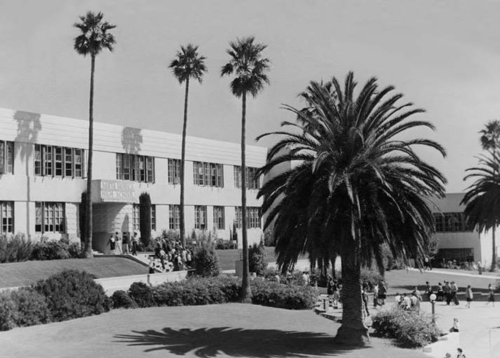
Samohi c. 1940. Photo: Santa Monica High School Campus Plan Historic Resources Technical Report, Historic Resources Group, July 2018
The Historic Core of the Santa Monica High School Campus constitutes a historic grouping that could become part of the Facilities Master Plan upgrades. The core consists of the English, History, Art, Business, and Business Annex Buildings, which retain their original 1913 location, WPA architectural character, and orientation atop Prospect Hill. By retaining the historic academic core of the campus, an opportunity to restore the original quad area as an open space that connects to the landmarked Barnum Hall and historic Greek Theater presents itself, enhancing the historic context of those two acknowledged, major historic resources.
History of Samohi Buildings and Artworks
Sited atop Prospect Hill overlooking the coast and the city, two buildings (History and Business) were built in 1913 and a third (English) in 1924. This first phase was designed by ubiquitous architects Allison and Allison, who also built 12 buildings at UCLA, including Royce Hall, and countless other well-known public and commercial buildings. After incurring severe damage from the 1933 Long Beach earthquake, the Samohi academic buildings were reconstructed in 1937 and, in 1940 a Business Annex was added, all with federal funds from the PWA/WPA New Deal programs. This phase of development was executed by master architects Marsh, Smith and Powell, who specialized in schools and churches in the Los Angeles region. Barnum Hall, the Art Building, the North Gym, and seven artworks integral to some of the buildings were also added at that time. A Historic Resources Assessment created for the School District in 2018 noted that “Santa Monica High School has the distinction of being home of the highest concentration of WPA projects in the city.” Santa Monica High School is virtually a PWA and WPA museum, and the concentration of resources that embody that significance citywide and beyond, marks a key moment in the history of the high school and the school district.
Historic Assessment of Santa Monica Schools
The School District has commissioned two different historic assessment studies. A 2008 assessment found that the campus as a whole was highly significant and appeared to be eligible for the California and National Registers of Historic Places, and that two buildings within the cluster, the History and English Buildings, could be eligible for individual designation. It surveyed all 17 SMMUSD campuses and identified many significant structures throughout the school district. That report, which cost over $477,000, was abandoned in draft form and was never acknowledged as an official survey. A second assessment in 2018, never mentioning the existence of the first report, also found strong evidence that the campus was historically significant and deepened the narrative on the importance of the post-earthquake reconstruction. But the historic academic buildings on Prospect Hill were nonetheless dismissed as historic resources. These buildings as a small grouping were never considered, and as individual historic buildings the condition of their historic features were given short shrift.
The Historic Resources at Samohi Tell a Citywide Story
Both reports focused closely on the schools including the Samohi campus, and thus did not consider how important the PWA and WPA are to the history of the City of Santa Monica as a whole. This broader significance adds another layer to the significance of the cluster, and to its value as an educational resource on the school campus. The New Deal programs transformed the City of Santa Monica. Our entire beachfront was remade from a narrow dirt road with a train track to the Roosevelt Highway that connected our city directly up the coast all the way to Oregon. The New Deal programs rebuilt Santa Monica with the Arizona overpass from the top of Palisades Park, and the Olympic Tunnel that passes beneath Palisades Park, which is now part of the 10 freeway. The city also used the programs for a number of infrastructure projects like the Pier Bridge and the roadways beneath it, storm drains and street paving, the widening and enhancement of the California Incline, construction of City Hall, the Main Street Bridge, and several artworks including the library murals recently re-installed in our new main branch, and the Saint Monica statue at the foot of Wilshire Boulevard in Palisades Park. The list goes on and on. Nothing has impacted how the city has developed to the extent that the WPA and PWA projects in the city did since the railroads that were built here in the 1870s and 1890s.
Therefore, the concentration of these projects that remain intact on the Santa Monica High School campus are a very important cluster representing not only Santa Monica High School history but an important phase in the development of the entire city, and represent the deep impact of the New Deal programs nationwide. In that context, the concentrated cluster of historic resources on top of Prospect Hill is even more significant. This proposed historic cluster warrants further study for designation at the local, state, and national levels.
What You Can Do
Please help by urging the School District to reconsider the Samohi campus plans to replace the historic buildings, and consider an alternative which preserves and rehabilitates them, so our community’s history remains visible for us and future generations.
- Write to the School Board and the District Superintendent and ask them to halt next summer’s demolition so preservation experts can examine the possibility of rehabilitating and modernizing the historic buildings. Remind them that rehabilitation teaches sustainability, and honoring the past as we modernize for the future gives context and value to the study of history and culture. Tell them that historic school buildings throughout the region and state have been successfully modernized without demolition and have won awards for it.
- Virtually attend an upcoming school board meeting (1st & 3rd Thursdays) and ask to comment.
- Sign the petition to save the buildings.
- Join the Santa Monica Conservancy and increase the reach of your voice for preservation in Santa Monica.
- Urge others to take these actions; share this flyer.
More Information
Santa Monica Conservancy analysis of previous Santa Monica High School assessments
2008-1120-PCRDraftAssessmentAllCampusesSMMUSD-
Santa Monica High School Campus Plan Historic Resources Technical Report
Santa Monica High School Cultural Resources
High Schools all over the country are approaching major modernization projects by combining adaptive reuse with new construction. In the examples below you will see rehabilitated spaces in historic buildings that look very much like the interior spaces proposed for the Samohi Campus. They win architecture and educational awards and attain high LEED status levels as well.
Venice High School, Los Angeles, California
Beverly Hills High School, Beverly Hills, California
North Hollywood High School, North Hollywood, California
Jordan High School, Los Angeles, California
Huntington Park High School, Los Angeles, California
Alameda High School, Alameda, California
Roosevelt High School, Portland, Oregon
Grant High School, Portland, Oregon
Lincoln High School, Seattle, Washington
North High School, Denver, Colorado
Update on Efforts to Restore the Landmarks Commission
June 3, 2020
All of us at the Santa Monica Conservancy are grieved by the recent killing of George Floyd and the pervasive social injustice that continues in our country. As a historic preservation nonprofit, we add our voice in supporting Black Lives Matter. We hope that this moment will greatly impact equity and justice in our communities.
One of the ways in which we are able to support our communities of color is through historic preservation. By saving and protecting historic places that tell their stories, we are able to educate future generations about our past. You may have seen this through the listing of Bay Street Beach Historic District on the National Register last year.
Two weeks ago, we reached out for your support in helping to save the Landmarks Commission. The impact of the global health crisis on our City and its historic preservation program has resulted in a restructured budget. It prioritizes essential City services as defined in the City Charter but includes suspension of this ever-needed Commission. More than 70 members of our preservation community wrote to City Council.
The Landmarks Commission is a fundamental responsibility of our local government. As defined by the municipal code, it is the heart of our City’s historic preservation program and part of the City’s planning framework. The Santa Monica Conservancy attends all Landmarks Commission’s public hearings and we must underscore that they are crucial for bringing to light historic information which City staff and consultants may not previously know. This community participation is a vital part of our process for identifying and protecting our valuable historic resources.
Additionally, we are very concerned about proposals to drastically increase applicant fees for Landmarks Commission services by as much as 5 to 10 times the existing fees. These increases are based on estimates for “full cost recovery.” This approach fails to recognize that historic preservation is a community benefit and makes designation of a landmark or historic district out of reach for all but the wealthiest property owners. Needless to say, it excludes the Conservancy and other nonprofits as well.
Conservancy Board members have met virtually with Planning Director David Martin and Interim City Manager Lane Dilg. We presented a number of specific strategies to restructure the Landmarks Commission that would reduce staff time, streamline processes, and reduce costs. We also offered our volunteer support in any capacity that could assist City staff. We do not yet know the results of these proposals.
However, be assured that our advocacy and your letters of support have made a difference! At the May 26 City Council meeting, Councilmember Ted Winterer, inquiring about the status of both the Architectural Review Board and the Landmarks Commission, was informed by Interim City Manager Lane Dilg that the ARB continues to meet in order to process project approvals, and that they are working on ways to allow the Landmarks Commission to continue. But we remain vigilant as long as the Commission is in limbo.
Saving historic places helps shape our identity and preserves the stories of our communities in a rapidly changing environment. We are so grateful for your commitment to historic preservation. Thank you!
We will keep you updated as soon as we learn what is proposed for the Council Budget Working Session on June 9. To read our third letter to City Council, click here. Our previous news post about our advocacy to stop the suspension of the Landmarks Commission can be found here.
Stop Santa Monica from Suspending the Landmarks Commission!
May 14, 2020
In response to the anticipated $224 million deficit in the City budget over the next two years, Santa Monica City Council has approved plans that include suspension of the Landmarks Commission. See the full press release here.
Stand with the Santa Monica Conservancy and send a strong message to the City to make sure they know how much the community values our Historic Preservation Program in Santa Monica. Read the Santa Monica Conservancy’s May 4 Response to City Council’s proposed plan and our May 9 Response to City Council’s plan to suspend the Landmarks Commission.
Send the sample letter below or show your support in your own words. Click the button to send a message or email council@smgov.net, clerk@smgov.net, david.martin@smgov.net, lane.dilg@smgov.net and copy us at advocacy@smconservancy.org. Please also forward this message to your friends and group lists.
Dear Council Members,
We all know, the City of Santa Monica is in dire financial straits and is looking to find ways to cut costs. Erasing the future important work of the Landmarks Commission, however, is too drastic.
Instead the City should streamline processes to keep the Historic Preservation Program viable and working.
Since its establishment by ordinance nearly 50 years ago, Santa Monica’s preservation program has safeguarded 137 historic sites, 13 structures of merit and 5 historic districts!
The members of the Commission are experts who not only designate landmarks and districts and oversee changes made to them, but also review demolition applications for unprotected historic resources. The loss of the Landmarks Commission means that all of our historic resources are at risk; landmarks that define Santa Monica’s unique identity and character.
Once a historic structure or site is lost, it is lost forever.
Please work with the Santa Monica Conservancy and other volunteers to find ways to streamline and reduce the cost of City procedures, support the Landmarks Commission and continue to implement historic preservation in our city. Preservation is one of our core community values. Don’t erase the Commission and risk demolition of our historic resources.
Sincerely,
[your name here]
Council Denies Appeal of Woodacres Designation
August 15, 2019
On August 13, Santa Monica City Council upheld the Landmark Commission designation of the John Parkinson residence at 808 Woodacres Road by a vote of 6-0 with one member absent. Speakers supporting the designation included Stephen Gee, author of a definitive book on Parkinson’s work, a representative of the Los Angeles Conservancy as well as several Santa Monica residents.
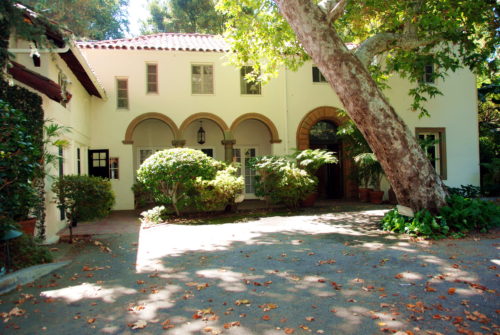
808 Woodacres Road. Photo: Michael Locke
The property, originally nominated by the Santa Monica Conservancy, was designated June 10 by a unanimous vote of the Landmarks Commission after two lengthy public hearings. For more on the significance of John Parkinson and the residence he built for his family in 1920 and occupied until 1945, click here.
Conservancy Wins Historic District Appeal!
July 24, 2019
On Tuesday evening, July 23, the Santa Monica City Council voted 6-0 to designate the 4th Street Corner Historic District, supporting the Santa Monica Conservancy’s position that the 14 contiguous and intact historic residential structures qualify as a historic district under the Santa Monica Landmarks Ordinance. The buildings represent an important period in the early residential development of Ocean Park following the western extension of what is now Ocean Park Boulevard to Main Street and the beach. Like the neighboring Third Street Neighborhood Historic District, a variety of architectural styles found in Ocean Park in the first third of the 1900s are represented in the district.
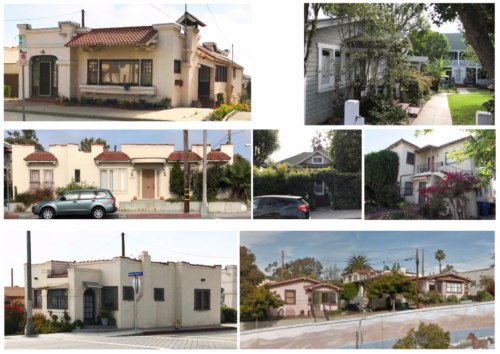
Contributors to 4th Street Corner Historic District.
In supporting the designation, Council voted to reject the assertions by planning staff and the City’s consultant that the district was not large enough to qualify as a district, a criterion which is not defined anywhere in the Santa Monica Landmarks Ordinance or in the National Register’s recommendations. Also rejected were claims that the properties were not distinguishable from any other small grouping of historic properties in Ocean Park. More background on the district and the controversies are outlined in this article.
Finally, the Conservancy thanks the neighborhood organizations and the many individuals who responded to an email petition and came out to speak in support of the district, demonstrating once again the importance of preserving these reminders of our history for our own well being and that of future generations!
Council Appeal of Woodacres Designation on July 23
July 17, 2019
Update: The 808 Woodacres hearing was continued at the request of the owner. It is currently scheduled for the Council Meeting on August 13. Please check the City Council agenda for any updates to that item.
The Conservancy’s nomination of John Parkinson’s residence at 808 Woodacres Road has been appealed by the owner and will be heard at the City Council Meeting on July 23rd, the same night as the 4th Street Corner Historic District. The Landmarks Commission voted unanimously for the designation, which was the focus of lengthy public hearings at their March and June meetings. The City’s consultant and two independent historic preservation firms (engaged by a neighbor who supports the nomination) all agreed that the residence met five of the six criteria for landmark designation.
To support this designation, send a message to councilmtgitems@smgov.net by noon on July 23.

808 Woodacres Road. Photo: Michael Locke
This house is the only extant example of iconic architect John Parkinson’s residences that he designed for himself. Parkinson is most noted for designing the LA Memorial Coliseum, Bullocks Wilshire, Los Angeles City Hall (a collaboration), Union Station and numerous other commercial and institutional buildings in downtown Los Angeles and at USC.
The owner is strongly opposed to landmark status, believing that her property value will be reduced. We believe the opposite is true– a landmark building of this stature, a famous architect’s residence designed by him.
The Landmarks Commission rationale for the Landmark designation, and the findings that they made regarding meeting the City’s criteria for designation include the following:
(1) It exemplifies, symbolizes, or manifests elements of the cultural, social, economic, political or architectural history of the City.
The subject property exemplifies the City’s early architectural and development history. As one of the few extant residences from the earliest phase of residential development in this portion of the City located north of San Vicente Boulevard along the southern rim of the Santa Monica Canyon, the property is significant as an increasingly rare example of early residential development in Santa Monica. Constructed in 1920, the property is an early example of residential development in the area that would later expand during subsequent years after its construction. Although the property was located in the City of Los Angeles until its annexation to the City of Santa Monica in 1979, it was generally referred to in City directories and other publications as a property situated in Santa Monica because of its location, siting, and access. Purchased by master architect John Parkinson in 1913, the 22-acre site was later subdivided into a new residential tract in 1946.
Overall, the property retains a strong sense of time and place from the first quarter of the twentieth century as it remains an estate-style property of approximately 54,000 SF. Although the building and property have been altered over time, most of the alterations are along secondary elevations or at the rear of the main structure. Despite its minor alterations, the residence substantially retains all aspects of integrity from its period of significance (1920-1935) and continues to convey its architectural characteristics of the Spanish Colonial Revival and Italian Renaissance Revival styles. Furthermore, the siting of the residence and overall site characteristics as an estate property continue to convey its historic association and character within the City of Santa Monica. Accordingly, the subject property satisfies this criterion
(2) It has aesthetic or artistic interest or value, or other noteworthy interest or value.
The subject property is an excellent example of its type, design, and style. Its design fully articulates John Parkinson’s design principles of Period Revival architecture and expresses his aesthetic and artistic ideals of the period and style. Characteristics including the deeply recessed doors and windows, smooth trowel-finish stucco exterior walls, barrel clay roof tiles, arched shaped openings, the crafted use of glazed terra cotta tiles, and the integration of a loggia and arcade enclosed by ornate spiral fluted terra cotta decorative columns with Corinthian capitals further epitomizes the design theories of its architectural style that is of aesthetic and noteworthy interest. The subject residence consists of high aesthetic and artistic qualities and therefore satisfies this criterion.
(3) It is identified with historic personages or with important events in local, state or national history.
The subject property was designed by architect John Parkinson who was a self-trained architect considered one of most influential designers in the region at that time. Parkinson is best known for his civic, commercial, and hotel projects, however also designed industrial buildings and residential properties. Parkinson is considered an important person at the local, state, and national levels for his masterful architectural work and the design of extraordinary, iconic buildings that influenced and defined Los Angeles’ visual and physical identity during a period of unparalleled expansion during the first half of the twentieth century. By the time the subject residence was completed, John Parkinson was a well-established architect in the Los Angeles area with several large commissions. It was around this time in 1920 that he partnered with his son to form the architectural practice of Parkinson & Parkinson. The firm designed notable and influential buildings in Los Angeles further exemplifying Parkinson as a prominent and notable architect. The property is identified with master architect John Parkinson, and therefore satisfies this criterion.
(4) It embodies distinguishing architectural characteristics valuable to a study of a period, style, method of construction, or the use of indigenous materials or craftsmanship, or is a unique or rare example of an architectural design, detail or historical type valuable to such a study.
The subject property is an excellent example of its type, design, and style reflecting the Spanish Colonial Revival style with influences from the Italian Renaissance Revival idiom. Its design fully articulates John Parkinson’s design principles of Period Revival architecture and expresses his aesthetic and artistic ideals of the period and style. Characteristics including the deeply recessed doors and multi-pane fenestration, smooth trowel-finish stucco exterior walls, barrel clay roof tiles, arched shaped openings, the crafted use of glazed terra cotta tiles, and the integration of a loggia and arcade enclosed by ornate spiral fluted terra cotta decorative columns with Corinthian capitals further epitomize the design theories of its architectural style. Other features associated with Parkinson’s work are evident on the residence including the horizontal emphasis of the property’s overall design and the aesthetic composition, scale, and articulation of the façade. The residence substantially retains all aspects of integrity from its period of significance (1920-1935) and continues to convey its historic significance, embodying distinguishing architectural characteristics of the Spanish Colonial Revival and Italian Renaissance Revival styles valuable to a study of its type and style. Furthermore, the subject property is a rare example that exemplifies Parkinson’s residential design philosophy and is the only known single-family residence of its type designed, constructed, and resided in by John Parkinson within the City. Therefore, the subject property satisfies this criterion.
(5) It is a significant or a representative example of the work or product of a notable builder, designer or architect.
The subject property was constructed in 1920 and designed by master architect John Parkinson as his personal residence. Parkinson was a self-trained architect who is considered one of the most influential designers as his work is recognized throughout the Southern California region. He is best known for his civic, commercial, and hotel projects, however he also designed industrial buildings and residential properties. The architectural styles of these buildings included Art Deco, Spanish Colonial Revival, Italian Renaissance, Art Deco, Classicism, Romanesque, and Beaux Arts. Parkinson helped define Los Angeles’ visual and physical identity during a period of unparalleled expansion during the first half of the twentieth century. He designed more than 400 structures in the Los Angeles area, including but not limited to the Homer Laughlin Building (1897, Grand Central Market) in downtown Los Angeles, the Los Angeles Memorial Coliseum (1923), Los Angeles City Hall (1928), and Bullocks Wilshire (1928-1929). The subject property is a rare example that exemplifies Parkinson’s residential design philosophy and is the only known single-family residence of its type designed, built, and resided in by master architect John Parkinson within the City of Santa Monica. Therefore, the subject property satisfies this criterion.
Fourth Street Corner District
July 15, 2019
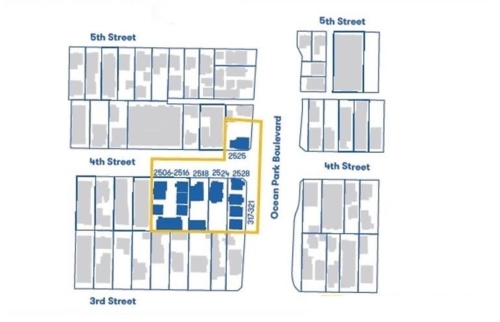
At the top of the incline where Fourth Street meets Ocean Park Boulevard is a collection of 14 intact historic residential buildings which convey what the neighborhood looked like in the early 20th century when they were built.
The Santa Monica Conservancy nominated these homes to become the Fourth Street Corner District. All the homes showcase historic architectural styles that are highly intact and uninterrupted with more modern structures, thereby making a cohesive historic district. Although smaller than the nearby Third Street Historic District, it’s larger and contains more historic homes than the recently designated 11th Street Historic District.
Inexplicably, the Landmarks Commission failed to support the application in a 3-3 tie vote. The Conservancy has filed an appeal and hopes to persuade City Council that this historic section of old Ocean Park deserves to be protected and preserved.
We need your help! The Conservancy’s appeal will be heard at the Council Meeting on July 23. Help us show Council members that neighbors and Santa Monica residents support the creation of the Fourth Street Corner Historic District. Write a message to City Council at councilmtgitems@smgov.net and copy us at district@smconservancy.org by July 23. Or click the button below to vote yes by emailing us.

Contributors to 4th Street Corner Historic District.
Background About the District
What unites these different examples of early residential architecture is their history– they were built following the western extension of Ocean Park Boulevard from Fourth Street to the beach in 1917. Before then, OP Boulevard ended at Fourth. After, with a major thoroughfare from the beach to Los Angeles, residential development followed. All but two of the residences in the district were built between 1917 and 1925. The group includes an unusual asymmetrical courtyard and all retain a high level of original design. In fact, 100% are contributors to the district.
The Conservancy became very concerned after learning that tenants in many of the structures had received Ellis Act eviction notices– indicating that these buildings were at risk of possible demolition or adverse alterations. Without historic district status, we could lose an important part of our history– and a unique corner of Ocean Park.
More About the Buildings
With the earliest building in the district dating from 1904 and the last from 1936, the variety of architectural styles portrays the evolution of residential homes in Ocean Park in that era. The 1904 house is a late Victorian hipped roof cottage with wood clapboard and shingle cladding, Corinthian columns supporting the porch, leaded glass windows and original windows and front door. A group of modest Craftsman “sister” bungalows parallels Ocean Park Boulevard, built around 1920. Other Craftsman homes are found in a bungalow court, a very unusual configuration as the buildings display various styles and construction dates. At the rear is a unique, one-of-a-kind fourplex with eclectic design features. A group of stucco clad bungalows at the corner are contemporary with the Craftsman homes, but represent a rare style in Santa Monica, deriving from Mission Revival precedents. Usually called Mediterranean, they have stepped parapet roofs, terra cotta tile on the roof and on shed roofs over openings, Craftsman-style windows, and detailed window design, including stained glass. This style evolved into Spanish Colonial Revival, a mature example of which is represented by the latest house in the district, a 1936 triplex that is already designated as a Structure of Merit. The City’s Historic Resources Inventory has listed all these buildings as landmark-eligible.
More About the Appeal
The consultant’s report and staff report did not support creating this district. The consultant objected to the size of the district, asserting that this group is a “cluster” and too small for a district. This objection is based upon their definition of “best practices,” and not by the definition of historic district in the Santa Monica Municipal Code and by the National Park Service. Santa Monica already has several small historic districts – the Bay Street Cluster consisting of four Craftsman-style multifamily buildings, and the 11th Street Historic District, with fewer homes and just 50% of the homes as contributing to the district.
The consultants and staff also asserted that the streetscape changes made in the late 1960s, during the Redevelopment period, diminished the integrity of the district. Although 4th Street and Ocean Park Boulevard were widened and an underpass created, these changes did not alter the integrity of the district at all, which retained its architectural and historical character intact.
The City Council hearing is “de novo,” meaning that they are not bound by the Landmarks Commission decision, but consider all the evidence and make their own determination.
Update on Home Savings: The Future of the Mosaic Mural and Artworks
June 11, 2019, updated on June 24, 2019
It has just been announced that the Millard Sheets mural and the other artwork at Home Savings at 2600 Wilshire Boulevard will be relocated to a museum in Orange County. Although the City of Santa Monica was given first priority as a relocation site for the Home Savings artworks according to the terms of the legal settlement agreement, they will be going to another location. (Learn more in this Santa Monica Lookoutarticle.)
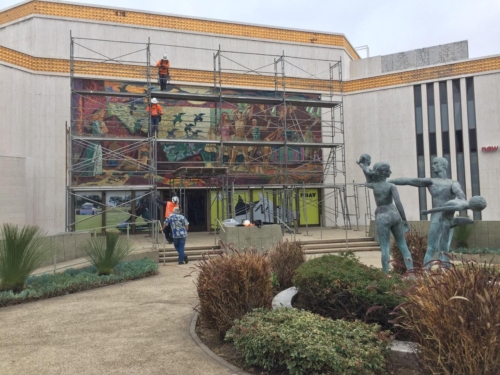
Preparations being made for removal of the mosaic mural on June 17, 2019.
The Museum of California Art at Chapman University will keep all of the decorative arts– the sculptures and stained glass in addition to the mural– together and available for public view and study.
The Conservancy’s efforts focused on preserving the entire collection of decorative arts in their original architectural framework, as emblematic of the Home Savings banks’ building program uniting art and architecture and the work of the Millard Sheets Design Studio.
We expect the mural removal to start shortly, so see it now while it’s here! The murals and artworks are accessible to the public. (Read more about the Home Savings building and Millard Sheets mosaic mural here.)
Landmark Status Reversed for Home Savings & Loan Building at 26th Street & Wilshire Boulevard
May 28, 2019
See it now before it’s gone! Santa Monica’s iconic Home Savings building at the corner of 26th Street and Wilshire Boulevard will soon lose its remarkable artworks, including the impressive mosaic mural depicting a beach scene. The loss is the result of the City’s settlement of a lawsuit brought against it by the property owner, reversing the landmark designation in 2013 as well as the Santa Monica Conservancy’s appeal to City Council, which once again confirmed the designation in 2017. This result allows the owner to remove the artwork and ultimately demolish the building. The owner’s stated intent is to relocate the artwork and obtain a charitable tax deduction for donating it to a yet undisclosed nonprofit organization.
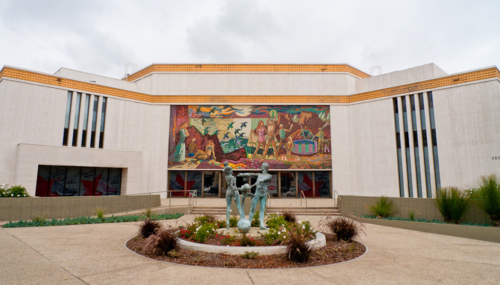
Photo: Peter Leonard
Designed in 1969 and completed in 1970, the Santa Monica branch is distinguished by its spacious entry plaza, which allows enjoyment of the dazzling mosaic mural. After Home Savings closed in 1998, the building was converted to retail use. The signature exterior mural with its brilliant colors is just one of a group of artworks integrated with the architecture of the building. The Home Savings building exemplifies the innovative collaboration of artist Millard Sheets with financier Howard Ahmanson.
Millard Sheets was a renowned artist, educator and promoter of art in Southern California, who was based in Claremont. The recently published Banking on Beauty by Adam Arenson describes Sheets and the Home Savings projects.
Beginning in the 1950s, Ahmanson commissioned Sheets to create a visual identity for Home Savings that would convey an image of security and financial stability, incorporating decorative artworks with themes linked to the local community. The monumental geometric masses clad in travertine with gold trim, enhanced with mosaics, sculpture and stained glass, became Home Savings’ recognizable identity, attracting customers seeking to build or purchase new homes during the Southland’s post-war building boom.
Sheets, in collaboration with artists at Sheets Design Studio, was given complete artistic freedom in designing these buildings. Millard Sheets’ name is writ large on the mosaic mural, which was executed by artist Nancy Colbath. The entry plaza sculpture of a family playing at the beach was created by Richard Ellis and the dolphin sculpture over the rear door by John Svenson. Inside, a large stained glass design by Susan Hertel is visible under a scrim.
Despite our efforts to dissuade the City from this settlement and persuade the owner to leave the artwork in its original setting, this important landmark will disappear. Visit it now because we understand that the removal of the mosaic mural is imminent.
City Council Designates 11th Street Bungalows
March 1, 2019
In January 22, Santa Monica City Council unanimously approved the designation of our city’s fourth historic district. The 11th Street Bungalow Historic District encompasses one block of 11th Street south of Wilshire Boulevard and around the corner on Arizona Avenue.

1223 11th Street. Photo: Santa Monica Mirror
This cluster of single-family historic homes is one of the few remaining groups of original single-family homes in Mid City and includes Craftsman houses, a late Victorian hipped roof cottage and a Spanish Colonial Revival home. The bungalows in the district, mostly Craftsman in style, were built between 1904 and 1925, during the city’s development eastward from the beach. They gave middle class residents affordable homes with a convenient floor plan and pleasing aesthetic.
In Santa Monica, special effects pioneer Ken Strickfadden, early civic leader Waldo Cowan, and locally renowned master builder Joseph Rowe called these bungalows home.
The designation culminates a 30-year effort by a grassroots coalition of Mid City Neighbors and local residents, tenants and owners, headed by co-chairs Susan Suntree and Diane Miller. The application was filed by Andrew Hoyer of Mid City Neighbors. Conservancy Board members Sherrill Kushner and Mario Fonda-Bonardi assisted the coalition. The Landmarks Commission unanimously decided to recommend the designation of the new historic district in December.
City staff will craft preservation guidelines with input from stakeholders. Property owners in the district are free to make any interior renovations they wish as well as develop the back of their properties.
The newly designated historic district joins the San Vicente Courtyard Apartments Historic District (formed in 2015), the Third Street Neighborhood District (1990) and the Bay Street Craftsman Cluster (2000).
Conservancy Nominates Landmark and Historic District for Designation
December 1, 2018
The Conservancy has nominated a residence and a group of cottages for landmark and historic district designation respectively.
Woodacres Estate
The historic residence is that of famed architect John Parkinson, one of the most prolific, masterful, and influential architects of Los Angeles. He designed the 1896 Homer Laughlin Building (Grand Central Market), the city’s first high-rise at 4th and Spring Streets (Braly Block) in 1904, as well as many commercial office buildings downtown in Beaux-Arts and Art Deco styles. Highlights of his career include the Alexandria Hotel, the Los Angeles Coliseum, the USC campus, L.A. City Hall (in collaboration with others), Bullocks Wilshire and Union Station (his last work).
Parkinson, a native of England, traveled to the U.S. with only a toolbox and five dollars and settled in Napa where he worked as a stair builder, taking on architectural commissions in his spare time. In 1889, he moved to Seattle but when his real estate investments soured and construction slowed during a severe national depression, Parkinson moved to Los Angeles and opened his architecture office in 1894.
Parkinson purchased 22 acres north of San Vicente Boulevard from the Santa Monica Land and Water Company. In 1920, he built Woodacres, his two-story Italian Renaissance-style home where he lived until his death in 1935.
4th Street Corner Historic District
On five parcels at the corner of 4th Street and Ocean Park Boulevard, development was triggered when Ocean Park Boulevard opened as a thoroughfare to Los Angeles in December 1917. The proposed district includes intact examples of the final build-out of the Ocean Park neighborhood representing late Victorian Cottage, Craftsman, and Mission Revival styles.
Thanks to the Advocacy Committee for its work on these nominations. David Kaplan brought the Parkinson house to our attention and Ruthann Lehrer and Roberta O’Donnell prepared the application. Nina Fresco prepared the historic district application.
Carousel Park Designated a Landmark
September 15, 2018
On September 13, the Landmarks Commission approved the designation of Carousel Park near the pier as a cultural landscape in September. The Conservancy joined with the Cultural Landscape Foundation, a national nonprofit dedicated to making our shared landscape heritage more visible, and preservation consultants Chattel, Inc. in co-sponsoring a designation application for the park.
The city-owned park was designated under five of the six possible criteria, recognizing the landscape’s place in the cultural history of the city, the aesthetic value of its design, and the importance of its designers, among other significant benchmarks. Recently threatened with destruction, the park has now become the youngest site on Santa Monica’s extensive list of local Landmarks.
Pier Bridge Proposals Raise Preservation Concerns
May 29, 2018
The “Pier Bridge” is the structure that connects Colorado Avenue to the Pier. It needs structural strengthening, improved access for the disabled and modifications to accommodate the ever-increasing number of pedestrians visiting the Pier. A Draft Environmental Impact Report (DEIR) for the replacement of the bridge was released earlier this year and has created serious concerns among members of the preservation community. Three proposals were described in the DEIR– two of which (nearly) double the width of the existing bridge, and one which creates a second bridge for cars only to the south at Moss Avenue.
The Conservancy’s comments on the DEIR stated that these proposals have unacceptably negative impacts on the nearby historic structures, including the Pier itself, the carousel building (known formally as the Looff Hippodrome, a National Historic Landmark), and the locally-designated landmark properties along the east side of Ocean Front Walk. The DEIR also failed to consider reasonable alternatives, such as the rehabilitation of the existing bridge and/or the elimination of parking on the Pier deck.
In addition, based on the research we have done to support our position, we have come to understand the significance of Carousel Park, located at the southeast corner of the Pier. It was designed by the local architectural firm Moore Ruble Yudell and landscape architects Campbell & Campbell, winners of a design competition hosted by the Santa Monica Citizen’s Pier Task Force, which was to create a Pier Master Plan in 1983 after winter storms destroyed over one-third of the length of the Pier. Carousel Park provides a welcoming gateway to the Pier, a children’s playground, ample bleacher seating with two lookout pavilions, as well access for bicycles and the disabled from Ocean Front Walk to the Pier deck. It is an essential element in attracting visitors to the Pier. The park received numerous awards following its opening.
The Conservancy has joined with the Cultural Landscape Foundation, a national nonprofit dedicated to making our shared landscape heritage more visible, and preservation consultants Chattel, Inc., to submit a Landmark designation application for the park.
It remains to be seen how these concerns will be addressed in the final Environmental Impact Report, which is expected to be presented to City Council for approval sometime this fall. If the final proposal does not minimize impacts on the many historically significant structures adjacent to the bridge, we will be asking for your support in demanding changes to the plan before Council grants its approval. Stay tuned….!
Update on the Civic Auditorium and Sports Field
July 1, 2018
At the June 27 City Council Meeting, Council voted unanimously to support moving forward on the “temporary” multipurpose sports field in place of the surface parking lot on the Civic Center site and to move forward with the Request for Proposals (RFP) seeking a development team to reimagine, renovate and operate the Civic Auditorium. The motion included a parking study intended to plan for the loss of parking resulting from the addition of the field and an effort to work with current users of the parking, including the Courthouse, and possibly the Coastal Commission to develop alternatives to provide replacement parking as needed. Moving forward with plans for additional field space at Memorial Park was also included.
We are delighted to see the commitment to issue an RFP for the Civic Auditorium reconfirmed. However, the one concern that was not resolved was the softball field overlay proposed in the staff report, pending additional conversations with the school district.
The request to add a softball field overlay to the “temporary” multipurpose sports field at the Civic causes great concern because of its impacts on the landmark Civic Auditorium, which is still without a plan for rehabilitation more than a year after the Civic Working Group made its report to Council. The multipurpose sports field as defined in the 2005 Civic Center specific plan was intended for sports like soccer that are played on rectangular fields. The softball overlay will add 25% to the area required for the sports fields, moving the boundaries of the field very close to the Auditorium, and includes fencing and containment netting 26 feet high, as well as chain-link protected dugouts and bullpens. The visual impact of such a field on the Landmark structure seems totally inappropriate, and it would place additional limitations on the space available for shared use by a revitalized Civic Auditorium.
It seemed clear that all council members saw the placement of the softball addition to the temporary field at the civic, even temporarily, as a negative impact, but they supported further conversations with the district regarding the need and district funding of the additional expense. The Conservancy will remain concerned about the potential negative impact on the future of the Civic Auditorium until a different site is found for the softball field.
Update on the Civic Auditorium and Sports Field
June 1, 2018
The fate of our landmark Civic Auditorium will be affected – and possibly decided – by Santa Monica City Council tomorrow night, when they will be receiving an update on the Civic Center sports field proposals. Council will be reviewing the results of discussions with the School District about cost-sharing on the permanent sports fields with two levels of parking below, and updated estimates on the costs of both the “temporary” and permanent sports fields.
We have new and very serious concerns about the two proposals and their impact on the future of the historic Civic Auditorium. In the discussions with the School District, a new use has been added to the proposed field, configuring it for softball as well as other sports. This significantly enlarges the impact of the field on the site and enlarges its footprint, because softball requires fencing and containment netting 26 feet high, as well as chain-link protected dugouts and bullpens.
While we support the creation of a sports field, clearly the addition of the softball field further constrains the possibilities for the revitalization of the Civic. This would contradict Council’s direction earlier this year requiring that a comprehensive plan for the sports field must ensure that future needs of the of the Civic Auditorium be considered and that the field would not impede its rehabilitation!
The staff report also analyzes several additional alternatives, including one, alternative 3, which:
- postpones development of the Multipurpose Sports Field at the Civic Center,
- develops a temporary Multipurpose Sports Field at Memorial Park,
- commits City staff to assist SMMUSD with identifying safe modes of transportation from Samohi to the park, and
- proposes to issue a RFP for Civic Auditorium Operator, as was recommended by the Civic Working Group and supported by Council in February 2016. The RFP would require that any proposal would be consistent with the sports field as described in the Civic Center Specific Plan in 2005, which was “of a size and dimension suitable for competitive youth soccer.”
This proposal is expected to deliver additional field space about eight months earlier than even the temporary Civic Center field because it is located out of the coastal zone and therefore avoids the problem of satisfying the Coastal Commission’s concern that no parking would be lost at the Civic that would impact access to the Coast.
It also ensures that when the Civic Center field is designed and built, the revitalization of the Civic Auditorium will be much more clearly understood.
Click here to read the full staff report and supporting documentation. The attachment labeled “Summary of options and alternatives” has a helpful analysis of the estimated costs, construction timeline, opportunities and challenges of the various proposals described by staff. Again, Alternative 3 is the Conservancy’s preferred alternative.
San Vicente Courtyard Apartments Historic District Approved!
December 17, 2015
Santa Monica has its first new historic district in fifteen years. The City Council, on the recommendation of the Landmarks Commission, voted unanimously on December 15, 2015 to designate the iconic courtyard housing on San Vicente Boulevard from Seventh Street west. (Read the City’s staff report here.) Through the grassroots efforts of the Historic San Vicente Coalition, assisted by the Conservancy and endorsed by many local community organizations, this district will be the third historic district in our city, joining the Third Street Neighborhood District and the Bay Street Craftsman Cluster.
The next step is for staff to draft an ordinance with input from stakeholders regarding guidelines for changes to the properties within the district. Interiors are not subject to restrictions.
Congratulations to all those who worked hard to successfully shepherd this designation through the landmarking procedures!
Update on the 5th Street Post Office
June 6, 2015
The building that housed Santa Monica’s main post office for over 70 years closed in June 2013. That August, the Santa Monica City Council (with strong support from the Conservancy) approved a preservation covenant for the building and assumed responsibility for its enforcement, clearing the way for the Postal Service to sell the property. It was purchased in December 2013 by 1248 5th Street, LLC as creative office space for Skydance Productions, headed by David Ellison.
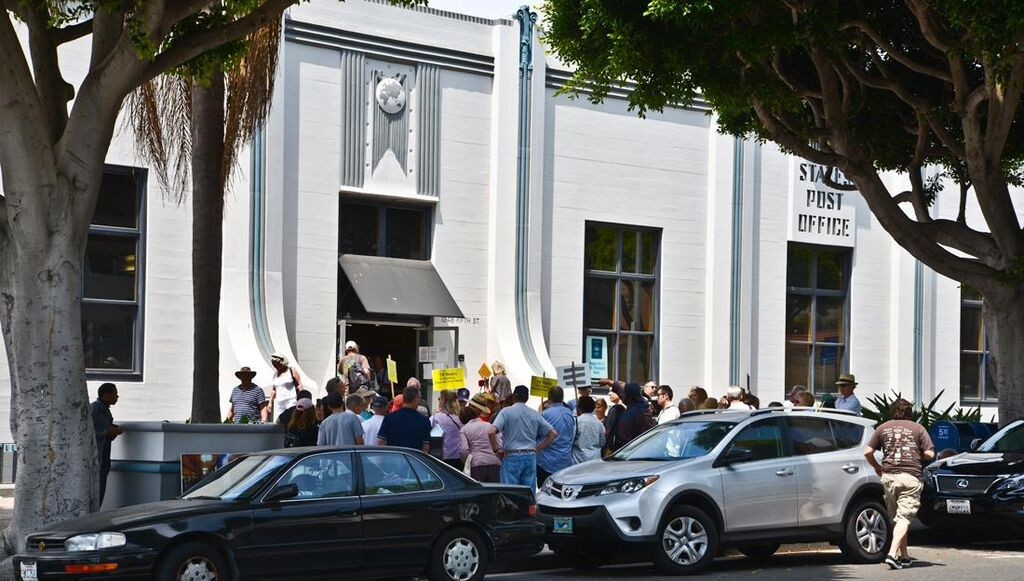
Over 90 people gathered for the Conservancy’s rally for the preservation of the historic 5th Street Post Office on June 29, 2013, its last day of operation. Photo Credit Mike Crosby.
The exterior of the building was designated as a landmark in March 2014. While the lobby was not included since it was no longer a public space, it is protected by the covenant that gives City Council the power to approve any changes. The Conservancy is currently advocating that the City Council delegate that responsibility to the Landmarks Commission.
Skydance has hired preservation architect Robert Chattel to oversee their plans. He will research the building and guide the plans so that they are compliant with the covenant, the landmark designation and the Secretary of the Interior’s Standards. Skydance has submitted an application for a discretionary review permit for their plans to rehabilitate the exterior and restore the historic lobby. Proposed changes include an addition on the rear of the building and two interior atria to bring in more natural light and air. One atrium will extend from the basement to the roof and the other will open from the first floor to the roof. The rear and interior changes will accommodate the addition of an enlarged second floor, a partial third floor and a roof terrace with the existing parapet serving as a guardrail.
The date for Landmarks Commission consideration of the plans is not yet determined.
Landmark Courtyard Apartments Threatened with Demolition — Again!
May 27, 2015
An Environmental Impact Report is being prepared for the demolition of Colonial Revival courtyard apartments at 423 Ocean Avenue to enable construction of a new 13-unit condominium complex. The property was landmarked in 2006 by a unanimous vote of the commissioners. The owners lost an appeal intended to overturn the designation by a unanimous vote of the city council. In 2013, an application for a certificate of economic hardship was filed, and the EIR now underway is a step in that process.
In order to grant a certificate of economic hardship in the case of demolition, the Landmarks Commission must make a finding that the designated landmark cannot be remodeled or rehabilitated in a manner which would allow a reasonable use of or return from such property to a property owner. The Conservancy has filed a detailed letter, outlining property’s historic significance and, according to state and local requirements, the analysis that must take place in the EIR if a finding of economic hardship is to be supported. Specifically, the letter notes that the financial return from preservation need not be superior to that of redevelopment, only “reasonable,” and requests that the analysis should include use of all financial incentives available to designated properties. Finally, renovation costs incurred because of the owner’s neglect cannot be considered. We are hopeful that if all these considerations are taken into account, it will be shown that there is a viable preservation alternative and the hardship certificate will be denied, opening the way for a productive use of the historic property.
Mills Act Incentives Threatened
December 1, 2013
The Mills Act, the state program that reduces property taxes on designated historic properties with approved restoration and maintenance plans, is Santa Monica’s only concrete incentive for historic preservation. The Landmarks Commission has been working to improve Santa Monica’s application and monitoring process by proposing explicit standards that ensure that contracts fulfill the intent and public purpose of the Mills Act. In March, the City Council will be asked to consider those recommendations, and to place limits both on the value of any individual contract and on the total value of contracts approved each year.
The Conservancy Board supports the Landmarks Commission recommendations, but is adamantly opposed to the proposed limits on the number and value of Mills Act contracts. To date, 57 historic buildings have awarded these contracts, at an average cost to the city of $2,300 per contract per year. The City’s total annual cost of this investment in the preservation of its historic properties is less than 0.3 % of property tax receipts!
Given Santa Monica’s high property values, some are concerned that the impact of the Mills Act on the City budget could be much greater in the future. We believe that the data does not support that concern. Fewer than 10% of the City’s properties are potentially eligible for the Mills Act, and only a small percentage of these are likely to seek designation. Furthermore, we do not see evidence of a rush to apply. In the 22-year life of the program, only two years – 2005 and 2006 – had more than 5 contracts approved.
Why, then, is the Conservancy so concerned about a cap on the contracts? We believe it will create a disincentive to designate and apply for a contract because of factors out of the property owner’s control. After investing the significant funds necessary to produce an application, the owner of a modest property could find that the number of submitted applications exceeds the cap and be forced to wait for some time to re-apply. A limit on the value of a contract could also discourage a buyer from the purchase and rehabilitation of a valuable property in poor condition, resulting in another loss to Santa Monica’s historic character.
Please watch your email and the Conservancy website for additional discussion of this issue once the staff report is published!
New Zoning Ordinance
The creation of a new Zoning Ordinance is an immense effort intended to incorporate the land use goals of the LUCE into a document that will govern growth in Santa Monica over the next twenty years. A subcommittee of the Landmarks Commission will work closely with the Commission as a whole, the Planning Commission, planning staff and members of the public to advocate for language in the ordinance that supports historic preservation. Along with the Santa Monica Conservancy, the group will work to include language that recognizes the importance of protecting historic resources in Santa Monica and that provides guidance, flexibility and incentives when any historic resource is a part of a building project.
In other reports, the Landmarks Commission has recently initiated actions on several historic resources. The Junipher Building, at 301 Wilshire Boulevard, was nominated for landmark designation last December 9, and is slated for review March 10. The Post Office building at Fifth and Arizona was nominated for landmark designation on January 13 and will also be considered March 10. The Home Savings Bank building at 2600 Wilshire Boulevard, with artwork by Millard Sheets, was designated a Santa Monica Historic Landmark in December, but has been appealed to the City Council. An appeal to overturn the designation of the Mayfair Theater terrazzo sidewalk paving at 210 Santa Monica Boulevard as Santa Monica’s 106th city landmark has been withdrawn. Lastly, the 100-year-old Bundy House at 401 25th Street was nominated for landmark status at the February Landmarks Commission meeting.
The Landmarks Commission is also pleased to congratulate the Santa Monica Conservancy and their perseverance in completing the entitlement process for the Shotgun House, a Designated Historic Landmark, thus allowing its relocation and restoration process to proceed. –By Barbara Kaplan
City Council Approves Covenant for Downtown Post Office
August 29, 2013
At its August 27 meeting, the City Council approved a preservation covenant for the former Post Office building at 1248 5th Street and assumed responsibility for the enforcement of the covenant. This cleared the way for the Postal Service to put the property up for sale, and the sign went up on the Arizona Street side of the building the next morning.
The Conservancy Board of Directors strongly supported this action by the Council, which addresses concerns that the Post Office might have been sold without a mechanism in place to prevent inappropriate alterations to the building. The new owner will be required to submit any proposed changes for the exterior and the lobby for review, as would be required of any structure designated under our Landmark Ordinance. The covenant’s description of the building’s character-defining features was developed by the Landmarks Commission, which is expected to nominate the building as a City Landmark once it is privately owned. This action will make the property eligible for preservation incentives such as the Mills Act.
Since the Postal Service announced its intention to close the Downtown Post Office over a year ago, the Santa Monica Conservancy has played an active role in opposing the closure and insisting on detailed plans for the preservation of the building. When appeals of the decision to close the Post Office were denied, the Conservancy was granted Section 106 Consulting Party status, giving us an advisory role in the process for determining conditions on future alteration of the building. We have made numerous statements to the Landmarks Commission urging a proactive role in protection of the building and expressing our support for the City’s assumption of responsibility for the covenant. The City of Los Angeles did the same when the historic Venice Post Office was sold in 2012.
The Conservancy has also made every effort to make the public aware of the process which was taking place and the importance of protecting the structure in any future adaptive reuse. A Conservancy rally at the 5th Street location on its last day of operation drew nearly 100 people, some of whom were unaware that the facility was to be closed.
Santa Monica is a city that prides itself on preserving its historic places. The Post Office building, as one of three Works Progress Administration (WPA) projects in the City, is an important a part of our history. The City’s acceptance of responsibility for the covenant ensures that the building’s future adaptive reuse will retain its historic character and will continue to communicate the story of the WPA era to our community.
Help Shape the Future of the Santa Monica Civic Auditorium
August 15, 2013
Help Shape the Future of the Santa Monica Civic Auditorium! If you have experience managing, building, booking, restoring or financing an entertainment venue – or know someone who does – the City of Santa Monica needs you!
A Civic Working Group (CWG) is being formed which will meet monthly to provide professional and community input on the renovation, programming and long-term operation of the Santa Monica Civic Auditorium. The CWG’s objectives are to work with City staff and consultants to:
- Draft a vision for the future cultural and community use of the Civic as the hub of a cultural campus
- Explore an appropriate mix of compatible adjacent uses, from open space to additional facilities as identified in the Urban Land Institute report
- Evaluate potential financing options and programming and operating models for the Civic
- Convene a community process to gather input and to build consensus regarding the future of the Civic
- Provide Council with recommendations regarding the vision, feasible renovation options and the preferred long-term operating model for the Civic.
The City seeks members who collectively demonstrate expertise in the areas of strategic planning, policy development, performing arts production, real estate development, construction, fundraising and event management. All applicants are welcome, but those who live or work in Santa Monica will be given priority.
Members of the CWG will be appointed for (1) two-year term. Five of the nine members will be selected by City Council in October. The remaining four will be current or former members of the Arts, Landmarks, Planning and Recreation and Parks Commissions, to be selected by the Commissions in September.
A three member Technical Advisory Subcommittee is also being formed. Members will possess extensive professional and technical expertise associated with the CWG objectives, in particular the financing, management and programming of venues similar to the Civic.
Follow this link for details and the application. Completed applications must be submitted by September 16. Santa Monica City Council will appoint the five positions on October 22, 2013.
Do you know someone who qualifies? You can post this information on a website, Facebook page or Twitter feed to reach interested people! Please share the link today!
If you would like to see who has applied so far, the Civic Working Group (CWG) now has its own listing on the Boards and Commissions page of the City website under “Task Forces” with links to the CWG applicants (click here) and the Technical Advisory Sub Committee (click here).
Thank you to Board Member Nina Fresco and the “Save the Civic” group for everything they have done to get us moving toward a plan for the future of this important building.
A Victory for Preservation Funding
May 29, 2013
Preservation as a “community benefit” in City development agreements moved a step forward in April as the Planning Commission forwarded the Century West Partners proposal for 1318 2nd Street on to City Council with a recommendation that $25,000 of approximately $500,000 in community benefit funding be allocated to historic preservation.
The project is a 4-story mixed-use building and involves the demolition of a property listed in the current Historic Resources Inventory as a potential contributor to previously identified historic districts. The Landmarks Commission approved demolition because its members did not see the building as having the level of significance that would merit consideration as an individual landmark. The Conservancy did not advocate for the project; our position was that, if the project moved forward, funding for preservation should be included in the agreement.
This positive vote was the culmination of months of effort by the Conservancy. The rationale for inclusion in the agreement was the stipulation in the Land Use and Circulation Element (LUCE) that preservation was one of five priorities for potential community benefits, as well as the fact that many of the highest priorities set forth in the City’s 2002 Historic Preservation Element remain unrealized. Seeing that current budget constraints limit the City’s ability to make progress against these priorities, we have been working with members of the Landmarks and Planning Commissions, Planning staff, and members of City Council to propose that a small portion of the total community benefits associated with development agreements might begin to address the needs stated in the Historic Preservation Element.
Examples include:
- A Preservation Resource Center for the community at the landmark Shotgun House
- Heritage education in our schools
- A program to support heritage tourism
- Inclusion of historic and cultural information in the Downtown Wayfinding Program
- A Transfer of Development Rights (TDR) program which would encourage preservation and adaptive reuse of historic structures
As of May 14, 2013, the ordinance defining the 1318 2nd Street Development Agreement was approved by City Council on first reading with the funding for preservation in place. The ordinance requires a second reading and vote at a subsequent Council meeting for adoption. This is schedule to take place on June 11, 2013
Whatever the outcome for this project, the Conservancy will continue to advocate for preservation funding to bring the priorities of the 2002 Historic Preservation Element much closer to reality.
Rally at Downtown Santa Monica Post Office
May 5, 2013
Join us on Saturday, June 29 at 11 AM for a rally to show your support for preservation of our downtown Santa Monica Post Office!
Meet us at the Fifth Street Post Office (1248 Fifth Street) on its last day of operation at this convenient and very historic location.
The Conservancy strongly supports an appropriate new use of the structure, but we are very concerned that the Post Office is closing without any formal protection for its character-defining features. We share the community’s disappointment over the loss of the convenience of the Fifth Street location, but now we must focus on putting the needed protections in place or we could lose yet another important, iconic downtown building.
Please remember that Saturday morning is Farmer’s Market day and allow ample time for parking if you are coming by car!
Protecting the Post Office
In 2012, the National Trust for Historic Preservation was so concerned about the lack of protection for the historic Post Offices that it named them to its annual list of endangered historic places. As soon as the U.S. Postal Service announced that it would sell the historic Fifth Street building a year ago, the Conservancy and others began advocating for the preservation of the building.
Built by President Franklin D. Roosevelt’s Works Progress Administration (WPA), the Moderne building with Art Deco appointments opened with great fanfare in July 1938.
Every historic preservation consultant who has looked at the building considers it eligible for the National Register of Historic Places. The Post Office qualifies as a Santa Monica Landmark as one of three WPA buildings in the City, and is distinguished by its Art Deco-inspired features including the beautifully detailed paneling and the original lighting fixtures of the lobby. The cities of Glendale, Southgate and Santa Barbara have landmarked their post offices, but that has not happened in Santa Monica.
The Postal Service has proposed a protective covenant describing the important features of the building. Under Federal law, it must identify the entity which will preserve and protect the property by enforcing the covenant before the Post Office can be sold.
“The current draft of the covenant leaves out important character-defining features like the 1937 plaque commemorating the building’s dedication, and could be weakened further in the sale negotiations if the City is not proactive. It is important to ensure local control over the building’s future. The Landmarks Commission must better define the attributes of the building listed in the covenant and the City should agree accept enforcement responsibility,” notes Carol Lemlein, Conservancy President. ”We cannot wait until after the Post Office passes into private hands and then landmark it. This process takes time, during which unacceptable alterations could be made to the building. And once the Post Office is closed, the lobby is no longer a public space and the Commission loses its ability to protect the important interior features.”
The protection of the Post Office building is expected to be on the July 8 Landmarks Commission agenda, which should be posted on the City website by Friday July 5.
Protection of the 5th Street Post Office
The fate of the Santa Monica 5th Street Post Office is featured in a New York Times article about preserving the nation’s historic post offices. Click here for NY Times article. The March 8, 2013 article describes how frustrated local and national preservationists are with the Postal Service’s execution of the federally mandated processes intended to protect historic buildings when they are sold. A photo essay including a photo of the lobby of our post office accompanies the article.
At this time, the status of our 5th Street Post Office is in flux. Under the Federal protection for historic buildings known as Section 106, the US Postal Service recently notified the Conservancy and other interested parties that the sale of the 5th Street Post Office would have “no adverse effect” upon Santa Monica because a protective preservation covenant would be placed on the building.
Some progress has been made toward instituting a covenant. Two consultants’ studies describing the building’s character-defining features have been completed, one for the Postal Service and one for the City. The Postal Service is reported to be reviewing the municipal code regarding Landmark designation and protection to determine if it offers adequate protection for the building.
However, after discussions with several of the consulting parties, including the California Preservation Foundation, the Conservancy responded that we could not agree to the finding of “no adverse effect” until the City’s designation process – or an equivalent public process involving the consulting parties – was used to define and protect the character-defining features of the building, and either:
- an agreement between the USPS and the City that the municipal code provides sufficient protection to meet the requirements of the Section 106 process; or
- the identification of a qualified entity to hold the required covenant, preferably the City of Santa Monica.
To date, the Conservancy has not heard back from the Postal Service on the status of the Section 106 process.
Santa Monica Pier to be Restored to Original Wood Condition
From Jared Morgan, Santa Monica Patch
November 1, 2012
The Santa Monica Pier could be on its way to becoming a full wooden boardwalk again, should a permit request filed by the City of Santa Monica be granted by the California Coastal Commission. The state agency will vote on the project—which will renovate 13,068-square-foot portion of the pier—at its Nov. 14 meeting in Santa Monica. ”Many people have probably noticed that for the last 10 years, the middle part of the pier has had metal plates in it,” said pier manager Rod Merl. The metal plates sit atop wooden pilings and were installed to address structural issues dealing with load balance, said Merl. There are 19 such wood pilings that the project intends to replace with concrete ones, “much like the west end of the pier, which got destroyed in a 1983 storm and was rebuilt in concrete pilings,” said Merl. Once the concrete structure is in place, the boardwalk can be fitted with wooden planks.
“We will be able to go back to having a real wooden boardwalk again,” said Merl. According to the California Coastal Commission staff report (attached), the permit should be approved with several conditions. Two such conditions require that public access to the pier be maintained and that compliance with the coastal access and marine resource protection policies of the Coastal Act are observed. Because the construction will be on the narrow west end of the pier, temporary trestles will be constructed so that there will be room to accommodate public access. The project could start as early as Nov. 19 and take as long as a year to complete.
Closure of the 5th Street Post Office
September 7, 2012
The Postal Service announced on August 17 that they are proceeding with plans to sell the historic Santa Monica Main Post Office and relocate its services to the carrier annex at 1653 7th Street, south of Colorado and the future Expo line. The Santa Monica Conservancy has joined the City of Santa Monica and others in writing letters to appeal this decision.
We are following this situation very closely, and are taking two additional initiatives to assure the protection of the building if our appeals to maintain retail service at the 5th Street location are denied and the Postal Service proceeds with plans to sell the building:
• Requesting Consulting Party status in the Section 106 Process defined by the National Historic Preservation Act
• Asking our Landmarks Commission to prepare a nomination of the Post Office
See below for details.
Our appeal of the Postal Service decision to close the 5th Street Post Office included the following points:
• The Santa Monica Main Post Office is a beautiful historic structure which is recognized in the City’s Historic Resource Inventory as being eligible for the National Register of Historic Places. It has been serving the community since its dedication in 1938 as part of the Federal Works Progress Administration.
• We are very concerned that the proposed sale of the Post Office will place this historic building at risk. The National Trust for Historic Preservation is so concerned about the failure of the Postal Service to provide adequate protections that it has named the Historic Post Offices to its 2012 list of the Nation’s Most Endangered Historic Places. (See below for additional description of the concerns about Postal Service adherence to federal laws intended to protect historic properties as they are sold into private ownership.)
• Closing the 5th Street Post Office and relocating its services to 7th Street may very well turn a profitable location into one that operates at a loss. The current location in the Central Business District is within walking distance of many local residents and businesses, and accessible by public transit. The outpouring of opposition describes the proposed location as much less convenient and indicates that the facility would be avoided by many – suggesting that it may not generate enough revenue to cover operating costs.
Our request for Consulting Party status in the Section 106 process defined by the National Historic Preservation Act: Under Section 106, the Postal Service cannot sell a historic property without a protective covenant to ensure that the historic property suffers “no adverse effects” when sold. Unfortunately, experience to date indicates the protections put in place are likely to be very weak unless local preservation organizations like the Conservancy request a consulting role. We will be making this request immediately without waiting for the results of the appeal, and will keep you informed of our progress.
Finally, the Conservancy has requested that the Santa Monica Landmarks Commission prepare a nomination of the Post Office so as to be ready to act as soon as the Post Office passes into private ownership, since they have no jurisdiction as long as the building remains a federal property. We understand that this will be on the Commission’s agenda for their next meeting, scheduled September 10 at 7 PM in the Council Chambers at City Hall.
Update on the Closure of the 5th Street Post Office
August 18, 2012
The Postal Service announced on August 17 that they are proceeding with plans to relocate the services of the historic Santa Monica Main Post Office to the carrier annex at 1653 7th Street, south of Colorado and the future Expo line. The Santa Monica Conservancy was among dozens of organizations and hundreds of residents who wrote letters opposing the closure at the time of the July 17 hearing.
We are following this situation very closely, and would like to bring you up to date on three initiatives we are taking:
- Joining appeals of the decision to relocate the Post Office
- Requesting Consulting Party status in the Section 106 Process defined by the National Historic Preservation Act
- Asking our Landmarks Commission to prepare a nomination of the Post Office
See below for details and how you can help.
Appeal of the Postal Service decision to close the 5th Street Post Office: It is our understanding that the City of Santa Monica will be making a formal appeal. The Conservancy will be sending its own letter opposing the decision for closure and ask you to do the same. The Conservancy’s letter will include the following points:
The Santa Monica Main Post Office is a beautiful historic structure which is recognized in the City’s Historic Resource Inventory as being eligible for the National Register of Historic Places. It has been serving the community since its dedication in 1938 as part of the Federal Works Progress Administration.
We are very concerned that the proposed sale of the Post Office will place this historic building at risk. The National Trust for Historic Preservation is so concerned about the failure of the Postal Service to provide adequate protections that it has named the Historic Post Offices to its 2012 list of the Nation’s Most Endangered Historic Places. See below for additional concerns about Postal Service adherence to federal laws intended to protect historic properties as they are sold into private ownership.
Closing the 5th Street Post Office may very well turn a profitable location into one that operates at a loss. The current location in the Central Business District is within walking distance of many local residents and businesses, and accessible by public transit. The outpouring of opposition describes the proposed location as much less convenient and indicates that the facility would be avoided by many – suggesting that it may not generate enough revenue to cover operating costs.
Your letters of support should be sent in time to arrive by August 31 to:
Vice President, Facilities
Pacific Facilities Service Office
1300 Evans Ave. Ste. 200
San Francisco CA 94188-0200
Requesting Consulting Party status in the Section 106 process defined by the National Historic Preservation Act: Under Section 106, the Postal Service cannot sell a historic property without a protective covenant to ensure that the historic property suffers “no adverse effects” when sold. Unfortunately, experience to date indicates the protections put in place are likely to be very weak unless local preservation organizations like the Conservancy request a consulting role. We will be making this request immediately without waiting for the results of the appeal, and will keep you informed of our progress.
Finally, the Conservancy has requested that the Santa Monica Landmarks Commission prepare a nomination of the Post Office so as to be ready to act as soon as the Post Office passes into private ownership, since they have no jurisdiction as long as the building remains a federal property. We understand that this will be on the Commission’s agenda for their next meeting, scheduled September 10 at 7 PM in the Council Chambers at City Hall.
Update on LA Commission Fails to Nominate Early Byers Adobe
August 1, 2010
The Spanish Colonial Revival house at 201 S. Rockingham is widely regarded as the project that launched the architectural career of John Byers. It was built 1919-1920 out of adobe bricks that were made on site. The house is an outstanding example of Byers’ work and is in excellent condition. (More details about the house and its story are below).
Although the house was marketed as one of the first homes in Brentwood Park, and previous owners had respected its historic character in making additions and renovations, it was sold recently to a buyer who plans to demolish it.
The Santa Monica Conservancy was asked for assistance, nominated the house as a Los Angeles Historic-Cultural Monument, and worked intensely to rally public support. The Los Angeles Conservancy supported the nomination as did many Westside residents as they became familiar with the history of the home.
Councilman Bill Rosendahl, who represents the district where it is located, opposed the nomination. With just 3 of the 5 members of the Cultural Heritage Commission present, the motion to approve the nomination received one vote in opposition and failed.
What does it mean to be a Landmark or Historic-Cultural Monument?
The landmark process does not seek to freeze the home in time. Rather, it identifies the significant attributes of a historic structure to be protected while allowing change so long as it is consistent with nationally recognized standards for the treatment of historic properties. Major additions can be made, building systems can be upgraded, and interiors can be remodeling reflecting an individual homeowner’s needs and taste. Preservation ordinances give owners a lot of flexibility with their properties and offer financial incentives as well.
In Los Angeles, designation as a Historic-Cultural Monument allows the Cultural Heritage Commision to object to and delay the issuance of a demolition permit, and activates the California Environmental Quality Act (CEQA) which protects historic buildings from adverse impacts without environmental review. For more information about Historic-Cultural Monuments, see www.preservation.lacity.org/commission.
John Byers was teaching Spanish and French at Santa Monica High School in 1919, when his wife’s cousin, Harry Johnson, asked him to act as translator to the Mexican workers hired to build an adobe house for him and his wife Olivia. Byers, who had built a home for himself and his wife and had traveled and lived extensively in Latin America, quickly became involved in the design and construction of this new adobe. The Johnson residence marked a turning point in his life, as he gave up teaching and devoted himself to architecture and building, starting a very successful career that lasted for decades.
 Byers is well known for the fine detailing and authenticity in design and construction of his Spanish Colonial Revival homes. He established shops where terra cotta tile, wrought iron and wood were hand crafted. Byers’ buildings are found across Southern California, particularly in Santa Monica, Brentwood and Pacific Palisades. His Bradbury House in Santa Monica Canyon is designated as a Los Angeles Historic-Cultural Monument and several of his homes as well as his office and the Miles Playhouse are designated as Santa Monica Landmarks.
Byers is well known for the fine detailing and authenticity in design and construction of his Spanish Colonial Revival homes. He established shops where terra cotta tile, wrought iron and wood were hand crafted. Byers’ buildings are found across Southern California, particularly in Santa Monica, Brentwood and Pacific Palisades. His Bradbury House in Santa Monica Canyon is designated as a Los Angeles Historic-Cultural Monument and several of his homes as well as his office and the Miles Playhouse are designated as Santa Monica Landmarks.
While some have questioned Byers’ role as the architect, it is clear that although he was not yet licensed at the time of construction, Byers and the architectural community of the 1920s considered 201 S. Rockingham as a Byers project. This is evident by the article written by Byers in the April 1929 issue of California Arts and Architecture, where the first page of the article includes a photo of 201 S. Rockingham with the caption declaring, “An Adobe House for Mr. H. R. Johnson at Brentwood Park. John Byers, Architect”.
Furthermore, in an August 1926 article by Harris Allen in Pacific Architect, there is a photo of the family room of 201 S. Rockingham. The caption reads, “Living Room for Mr. Harry R. Johnson, Brentwood Park, Santa Monica California. Designed by John Byers.”
Construction of the house was extensively photographed and documented in scrapbooks, copies of which were given to the Conservancy. Olivia Johnson wrote: “Thank God for John Byers, a trained architect, who added interest and beauty to our rather stark plan!”
Help Save An Early John Byers Adobe!
July 1, 2010
The Santa Monica and Los Angeles Conservancies need your help with an important preservation issue in Brentwood where a significant historic home is threatened with demolition.
The Spanish Colonial Revival house at 201 S. Rockingham is widely regarded as the project that launched the architectural career of John Byers. It was built 1919-1920 out of adobe bricks that were made on site. The house is an outstanding example of Byers’ work and is in excellent condition. More details about the house and its story are below.
Although the Johnson house was marketed as one of the first homes built in Brentwood Park, it was sold recently to a buyer who plans to demolish it. The Santa Monica Conservancy was asked for assistance and nominated the house as a Los Angeles Historic-Cultural Monument.
The nomination will succeed only with political support, and if people like you take an active part in voicing support for protecting the house. We are asking you to help by sending an email message to the Los Angeles Cultural Heritage Commission (LACHC) President Richard Barron at chc@lacity.org before Thursday July 29, 2010, the date that the nomination will be heard before the Cultural Heritage Commission.
- Please copy Councilman Rosendahl councilman.rosendahl@lacity.org if you are a resident of his district, and state that in the letter.
- Also send a blind (bcc:) copy of your message to info@smconservancy.org so we will know that you have cast your vote for preservation!
Finally, please send this on to other friends and relatives who are preservation-minded and wish to save the most important buildings representing our cultural heritage.
Thank you so much for your help!
Talking points for your email:
- I urge you (and Councilman Rosendahl) to support the nomination of the Johnson Residence at 201 S. Rockingham as a Historic-Cultural Monument.
- The house is an architectural treasure and a rare example of adobe construction.
- The house is notable for launching the architectural career of John Byers, its construction of adobe brick and that it led the revival of Spanish Colonial residential architecture in California.
- It has survived for 90 years in excellent condition.
- Preserving and protecting our heritage is important to me as a voter.
What does it mean to be a Landmark or Historic-Cultural Monument?
The landmark process does not seek to freeze the home in time. Rather, it identifies the significant attributes of a historic structure to be protected while allowing change so long as it is consistent with nationally recognized standards for the treatment of historic properties. Major additions can be made, building systems can be upgraded, and interiors can be remodeling reflecting an individual homeowner’s needs and taste. Preservation ordinances give owners a lot of flexibility with their properties and offer financial incentives as well. For more information about Historic-Cultural Monuments, see www.preservation.lacity.org/commission
John Byers and the Johnson House
John Byers was teaching Spanish and French at Santa Monica High School in 1919, when his wife’s cousin, Harry Johnson, asked him to act as translator to the Mexican workers hired to build an adobe house for him and his wife Olivia. Byers, who had built a home for himself and his wife and had traveled and lived extensively in Latin America, quickly became involved in the design and construction of this new adobe. The Johnson residence marked a turning point in his life, as he gave up teaching and devoted himself to architecture and building, starting a very successful career that lasted for decades.
Byers is well known for the fine detailing and authenticity in design and construction of his Spanish Colonial Revival homes. He established shops where terra cotta tile, wrought iron and wood were hand crafted. Byers’ buildings are found across Southern California, particularly in Santa Monica, Brentwood and Pacific Palisades. His Bradbury House in Santa Monica Canyon is designated as a Los Angeles Historic-Cultural Monument and several of his homes as well as his office and the Miles Playhouse are designated as Santa Monica Landmarks.
While some have questioned Byers’ role as the architect, it is clear that although he was not yet licensed at the time of construction, Byers and the architectural community of the 1920s considered 201 S. Rockingham as a Byers project. This is evident by the article written by Byers in the April 1929 issue of California Arts and Architecture, where the first page of the article includes a photo of 201 S. Rockingham with the caption declaring, “An Adobe House for Mr. H. R. Johnson at Brentwood Park. John Byers, Architect”. Clearly Byers claimed responsibility for the design of the residence. Furthermore, in an August 1926 article in Pacific Architect, there is a photo of the family room of 201 S. Rockingham and the caption reads, “Living Room for Mr. Harry R. Johnson, Brentwood Park, Santa Monica California. Designed by John Byers.”
The Santa Monica Conservancy responded to a request for assistance with the nomination. The Los Angeles Conservancy supports the nomination as well.
